Search Result
Results for "
macrocyclic
" in MedChemExpress (MCE) Product Catalog:
49
Biochemical Assay Reagents
2
Isotope-Labeled Compounds
| Cat. No. |
Product Name |
Target |
Research Areas |
Chemical Structure |
-
- HY-162234
-
|
|
PKC
|
Others
|
|
PKCTheta-IN-1 (Compound 19) is a selective macrocyclic PKCTheta inhibitor with IC50 value of 0.1 nM .
|
-
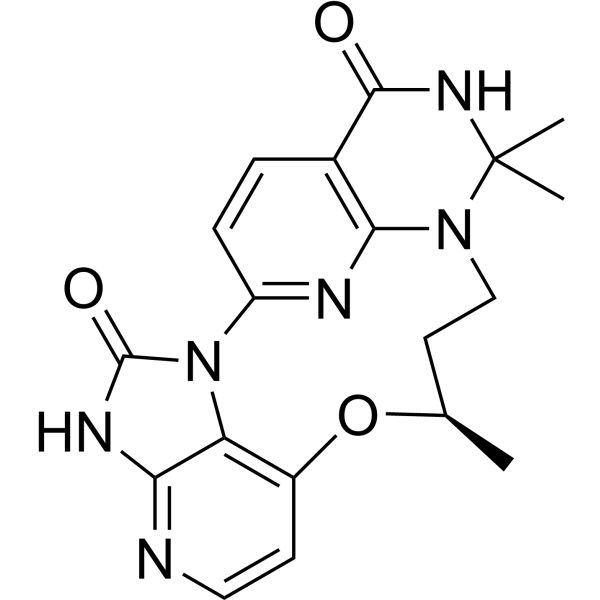
-
- HY-158150
-
|
|
Proteasome
|
Cancer
|
|
20S Proteasome-IN-5 (Compound 5) is a macrocyclic inhibitor of the 20S Proteasome, with IC50 values of 0.19 and 52.5 μM for ChT-L and PGPH-L activity, respectively .
|
-

-
- HY-147429A
-
|
Abx MCP TFA; RG6006 TFA
|
Antibiotic
Bacterial
|
Infection
|
|
Zosurabalpin TFA is a tethered macrocyclic peptide antibiotic, acting specifically on A. baumannii. Zosurabalpin TFA inhibits lipopolysaccharide-transport .
|
-

-
- HY-N10362
-
|
|
Dipeptidyl Peptidase
|
Metabolic Disease
|
|
Ellipyrone B, an antihyperglycemic γ-pyrone enclosed macrocyclic polyketide, shows inhibition potential against dipeptidyl peptidase-4 (IC50=0.48 mM) .
|
-
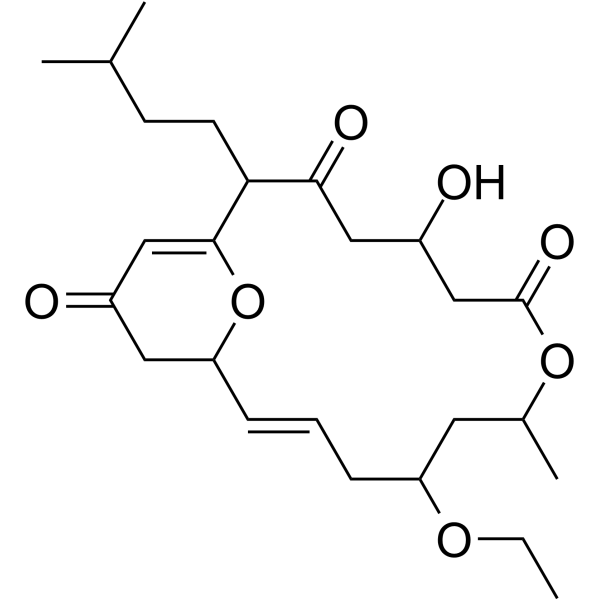
-
- HY-148340
-
|
|
Others
|
Others
|
|
24RBPyBC is a dinucleating macrocyclic ligand, it contains phenolate pyridine, bipyridine, and amino groups form dinuclear Fe(II) and Fe(III) complexes .
|
-
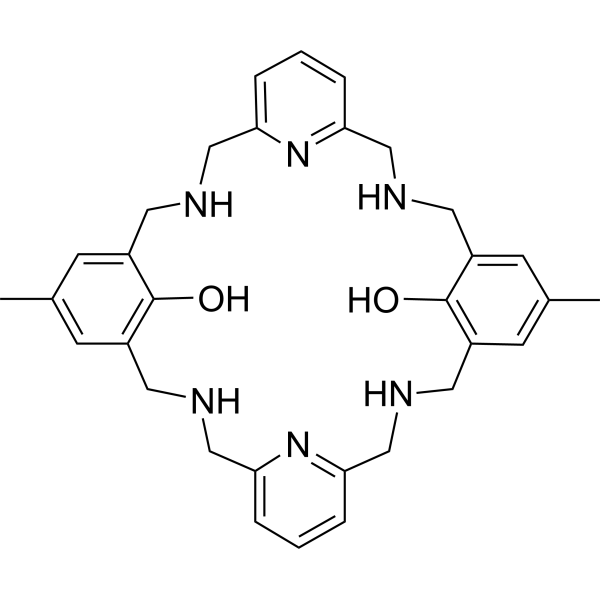
-
- HY-161079
-
|
|
Parasite
|
Infection
|
|
TDI-8304, a macrocyclic peptide, is a potent, species selective, and noncovalent Plasmodium falciparum (Pf20S) inhibitor. TDI-8304 shows highly selective for Pf20S over human proteasomes .
|
-
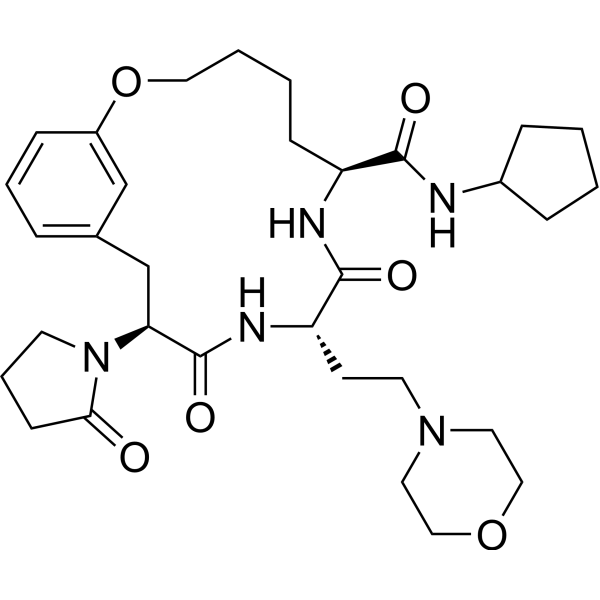
-
- HY-161370
-
|
|
Ser/Thr Protease
|
Cancer
|
|
VD4162 (Compound 8b) is a macrocyclic inhibitor of serine proteases. VD4162 can significantly improve potency for all four target enzymes TMPRSS2 (IC50 = 3.7 nM), HGFA(IC50 = 3.3 nM), matriptase (IC50 = 2.9 nM), and hepsin (IC50 = 0.54 nM). VD4162 can be used for the research of cancer .
|
-
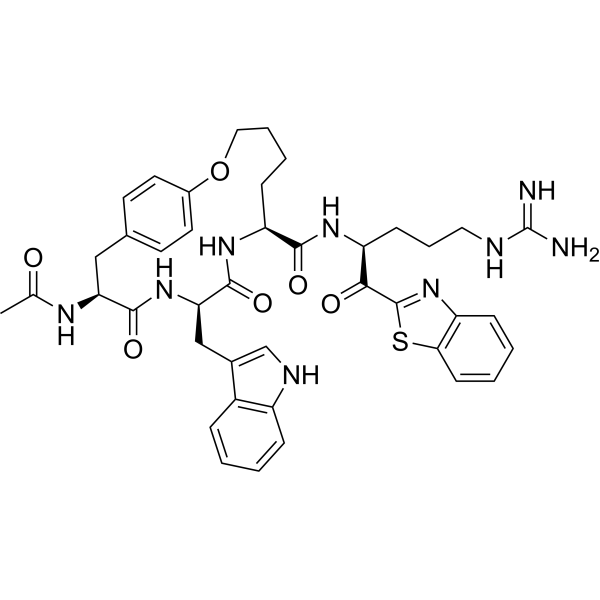
-
- HY-144617
-
|
|
DYRK
|
Cancer
|
|
JH-XIV-68-3 is a selective macrocyclic inhibitor of DYRK1A/B. JH-XIV-68-3 displays selectivity for DYRK1A and close family member DYRK1B in biochemical and cellular assays. JH-XIV-68-3 demonstrates antitumor efficacy in head and neck squamous cell carcinoma (HNSCC) cell lines .
|
-
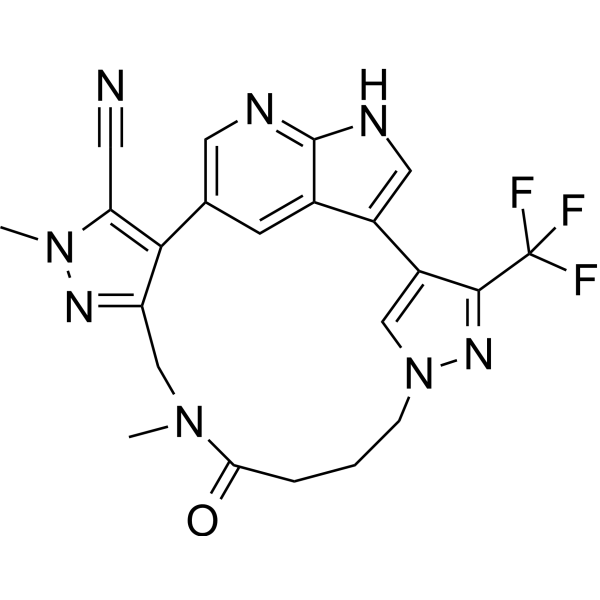
-
- HY-P5963
-
-
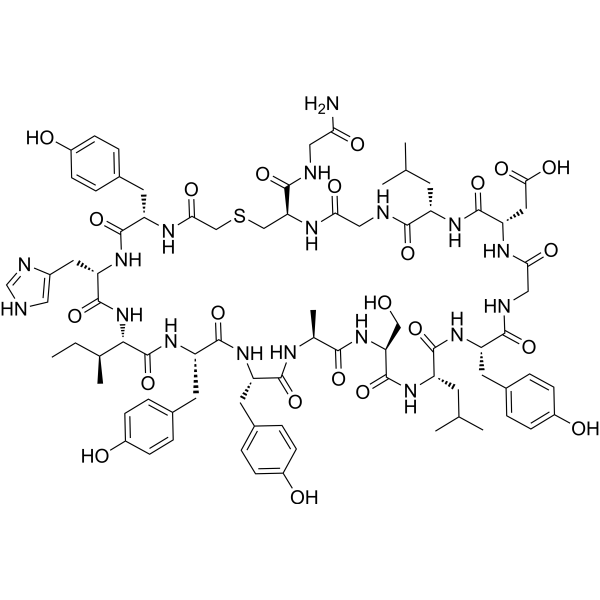
-
- HY-19628
-
|
|
RIP kinase
TGF-β Receptor
|
Inflammation/Immunology
|
|
OD36 is a RIPK2 inhibitor with an IC50 of 5.3 nM. OD36 is a macrocyclic inhibitor with potent binding to the ALK2 kinase ATP pocket. OD36 shows ALK2-directed activity with KDs of 37 nM .
|
-
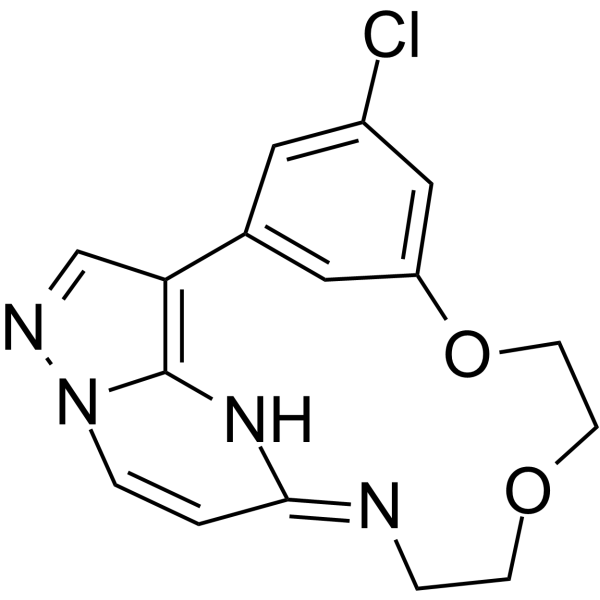
-
- HY-19628A
-
|
|
RIP kinase
TGF-β Receptor
|
Inflammation/Immunology
|
|
OD36hydrochloride is a RIPK2 inhibitor with an IC50 of 5.3 nM. OD36 hydrochloride is a macrocyclic inhibitor with potent binding to the ALK2 kinase ATP pocket. OD36 hydrochloride shows ALK2-directed activity with KDs of 37 nM .
|
-
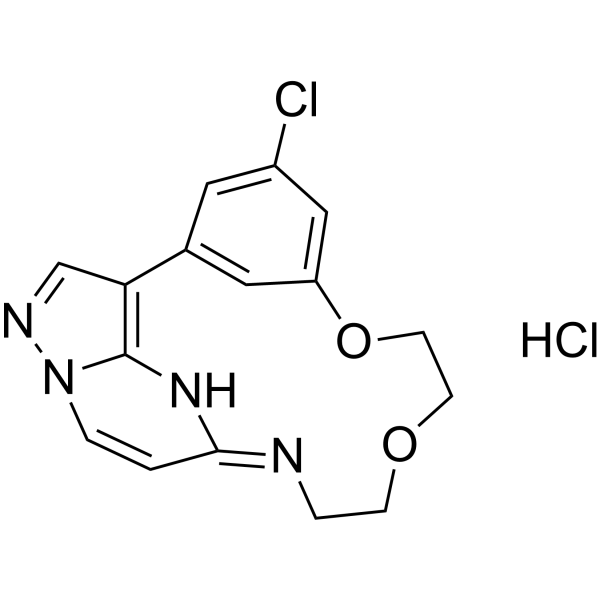
-
- HY-N7765
-
|
|
HCV
Bacterial
Apoptosis
Fungal
|
Infection
Inflammation/Immunology
Cancer
|
|
Oenothein B is a dimeric macrocyclic ellagitannin and has widely pharmacological activities, including antioxidant, anti-inflammatory, antifungal, anti-HCV, and antitumor properties. Oenothein B is a potent and specific inhibitor of poly(ADP-ribose) glycohydrolase .
|
-
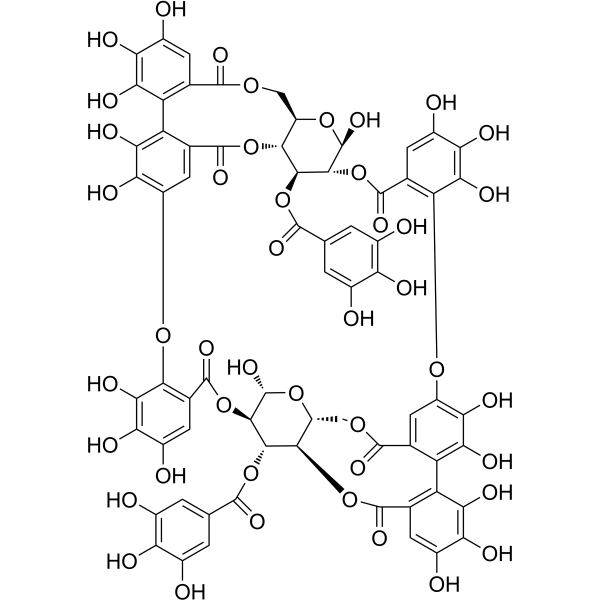
-
- HY-N10360
-
|
|
Dipeptidyl Peptidase
|
Metabolic Disease
|
|
Ellipyrone A, a γ-pyrone enclosed macrocyclic poyketide, shows inhibition potential against dipeptidyl peptidase-4 (IC50=0.35 mM). Ellipyrone A also has anti-carbolytic property against α-glucosidase (IC50=0.74 mM) and α-amylase (IC50=0.59 mM) .
|
-

-
- HY-144451
-
|
|
Trk Receptor
|
Cancer
|
|
TRK-IN-12 (Compound 9e) is a potent inhibitor of TRK (TRK G595R IC50 = 13.1 nM). TRK-IN-12 is a macrocyclic derivative compound. TRK-IN-12 shows significant antiproliferative activity in the Ba/F3-LMNA-NTRK1 cell line (IC50 = 0.080 μM). TRK-IN-12 has shown a better inhibitory effect (IC50 = 0.646 μM) than control agent LOXO-101 in Ba/F3-LMNA-NTRK1-G595R cell line .
|
-
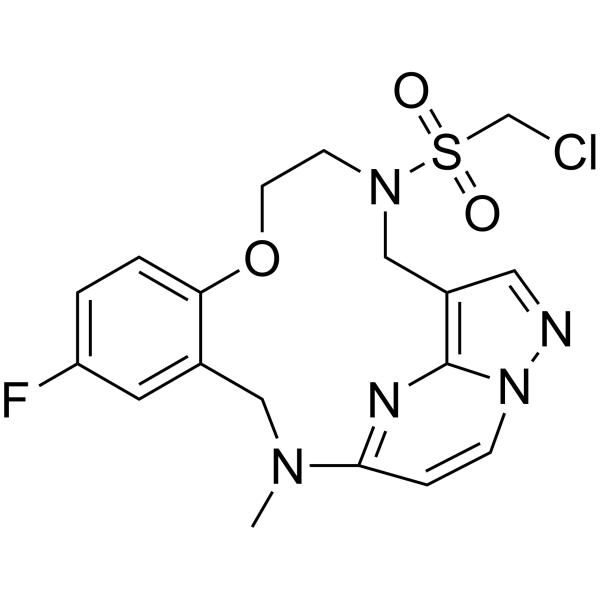
-
- HY-P3502
-
|
RA101495; RA3193
|
Complement System
|
Inflammation/Immunology
|
|
Zilucoplan (RA101495), a 15-amino acid macrocyclic peptide, is a potent complement component 5 (C5) inhibitor. Zilucoplan can be used in research of immune-mediated necrotising myopathy (IMNM) .
|
-
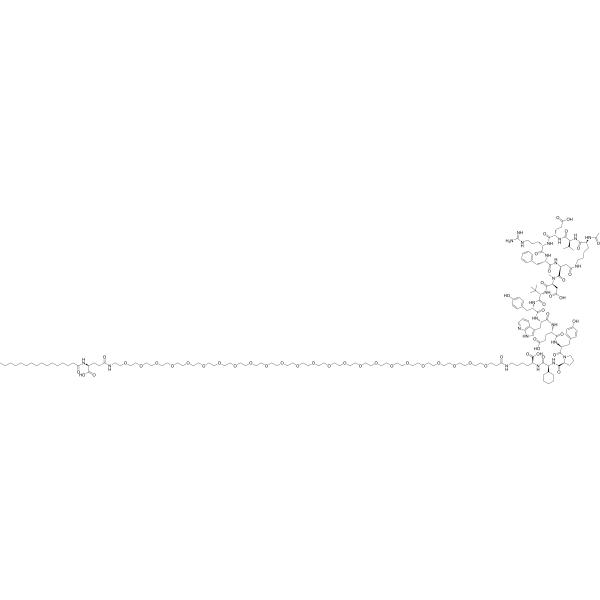
-
- HY-144068
-
|
|
Influenza Virus
|
Infection
|
|
Cap-dependent endonuclease-IN-25 is a potent inhibitor of cap-dependent endonuclease (CEN). Cap-dependent endonuclease-IN-25 is a macrocyclic pyridotriazine derivative. Cap-dependent endonuclease-IN-25 has the potential for the research of viral infections caused by viruses belonging to the Orthomyxoviridae family (extracted from patent WO2020075080A1, compound 4) .
|
-
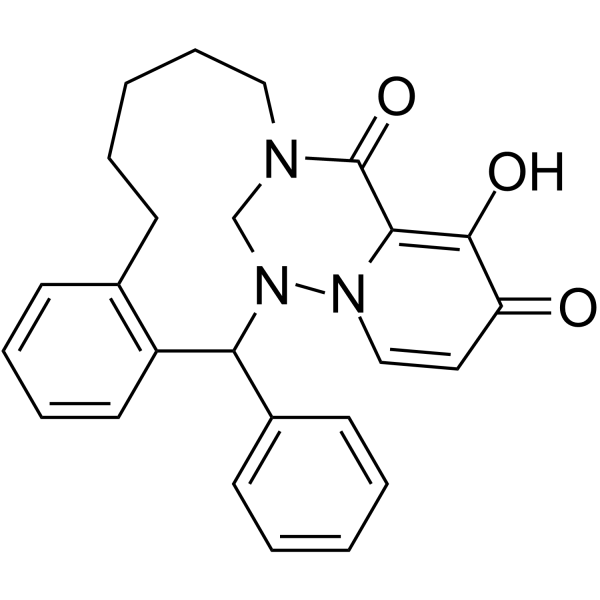
-
- HY-142947
-
|
|
Ras
|
Cancer
|
|
KRAS G12C inhibitor 45 (compound 78) is a potent KRAS G12C inhibitor .
|
-
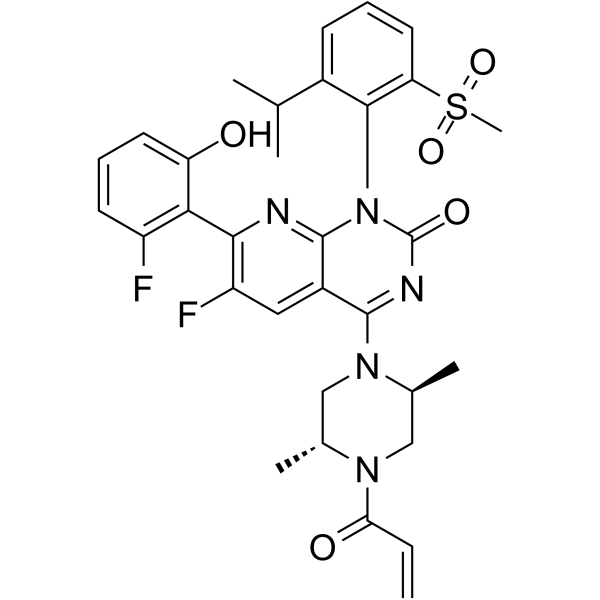
-
- HY-W540023
-
|
|
ADC Linker
|
Cancer
|
|
Endo-BCN-Fmoc-L-Lysine is a linker containing the lyophilic bidentate macrocyclic ligand endo-BCN, which can further synthesize macrocyclic complexes. In click chemistry, endo-BCN can react with molecules containing azide groups to form stable triazoles in the absence of catalysts.
|
-

-
- HY-W614269
-
|
|
Others
|
Others
|
|
DOTA-GA(tBu)4 is a macrocyclic chelator used in medical imaging .
|
-
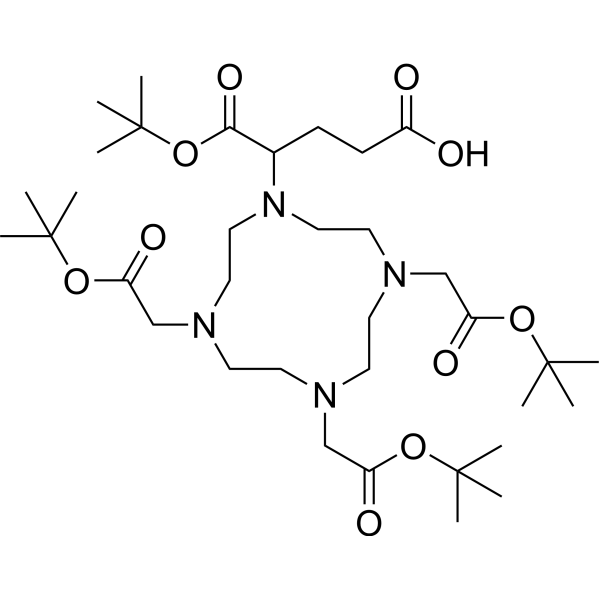
-
- HY-160131
-
|
|
Others
|
Cancer
|
|
Macropa is a macrocyclic chelator that can be used as radionuclides to study soft tissue metastases .
|
-
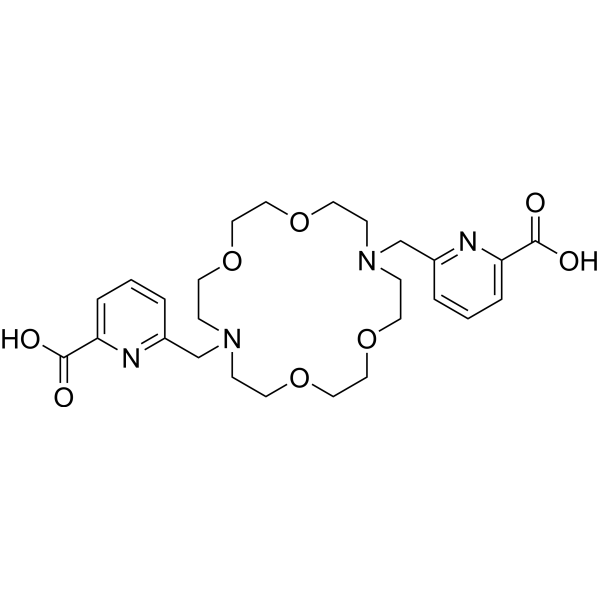
-
- HY-N12730
-
|
|
Others
|
Others
|
|
Euphoscopin B (compound 5) is a cytotoxic macrocyclic diterpene isolated from Euphorbia helioscopia L .
|
-

-
- HY-N12731
-
|
|
Others
|
Others
|
|
Epieuphoscopin B (compound 3) is a cytotoxic macrocyclic diterpene isolated from Euphorbia helioscopia L .
|
-

-
- HY-N10585
-
|
|
Antibiotic
Bacterial
|
Infection
|
|
Malacidin B is a macrocyclic lipopeptide antibiotic that shows antibacterial activity in a calcium-dependent manner .
|
-
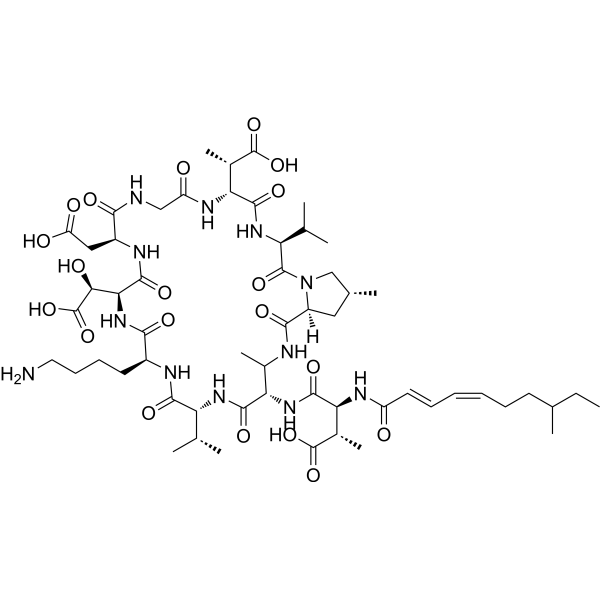
-
- HY-156323
-
|
|
ADC Linker
|
Cancer
|
|
BCN-exo-PEG4-NHS is an ADC Linker containing 4 PEG units. BCN-exo-PEG4-NHS contains the lyophilic bidentate macrocyclic ligand BCN, which allows for further synthesis of macrocyclic complexes. In click chemistry, BCN reacts with molecules containing azide groups to form stable triazoles in the absence of catalysts.
|
-
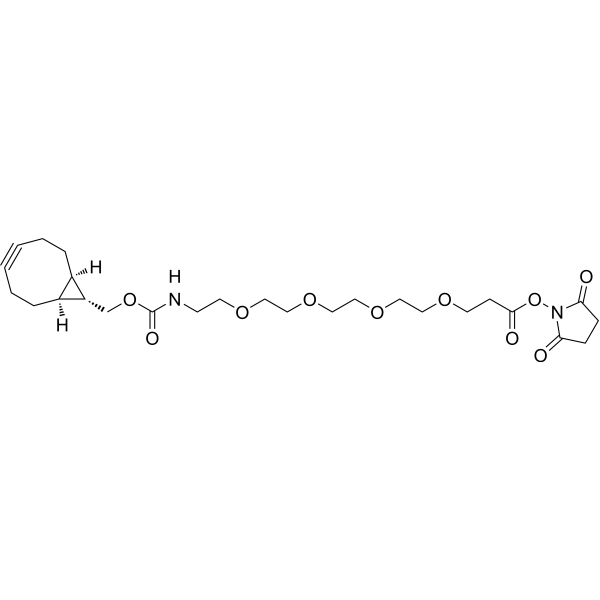
-
- HY-156324
-
|
|
ADC Linker
|
Cancer
|
|
BCN-exo-PEG8-NHS is an ADC Linker containing 8 PEG units. BCN-exo-PEG8-NHS contains the lyophilic bidentate macrocyclic ligand BCN, which allows for further synthesis of macrocyclic complexes. In click chemistry, BCN reacts with molecules containing azide groups to form stable triazoles in the absence of catalysts.
|
-

-
- HY-W007656
-
|
|
Others
|
Others
|
|
Cyclen is the aza analogue of crown ether, used as a precursor for MRI contrast agents, and is an intermediate for the preparation of effective macrocyclic chelates .
|
-

-
- HY-I0179
-
|
|
HCV Protease
|
Infection
|
|
ITMN 4077 is a macrocyclic inhibitor against Hepatitis C Virus (HCV) NS3 protease (EC50: 2131 nM) .
|
-

-
- HY-W035362
-
|
|
Others
|
Others
|
|
ω-Pentadecalactone is a fragrance ingredient. ω-Pentadecalactone is a member of the fragrance structural group macrocyclic lactone and lactide derivative .
|
-
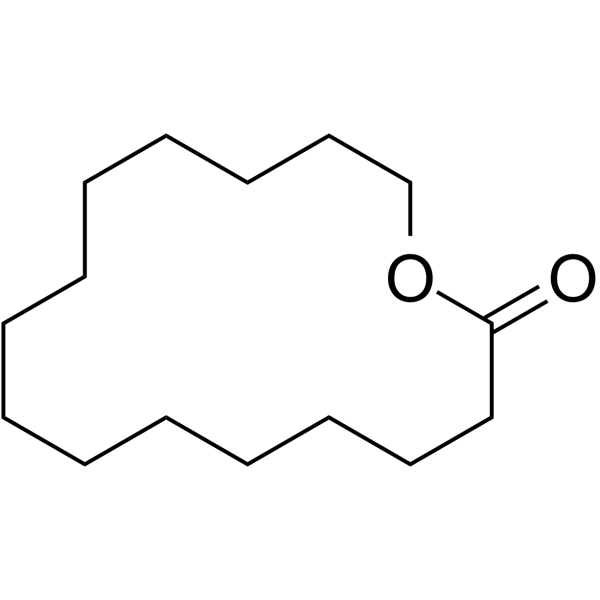
-
- HY-16217A
-
|
ZK 135079 hydrate
|
Biochemical Assay Reagents
|
Others
|
|
Gadobutrol (ZK 135079) hydrate is a nonionic paramagnetic macrocyclic gadolinium-based contrast agent that can be used for magnetic resonance imaging (MRI) .
|
-

-
- HY-156317
-
|
|
ADC Linker
|
Cancer
|
|
BCN-endo-PEG7-maleimide is an ADC Linker containing 7 PEG units. BCN-endo-PEG7-maleimide contains the lyophilic bidentate macrocyclic ligand endo-BCN, which can further synthesize macrocyclic complexes. In click chemistry, endo-BCN can react with molecules containing azide groups to form stable triazoles in the absence of catalysts.
|
-

-
- HY-156319
-
|
|
ADC Linker
|
Cancer
|
|
BCN-exo-PEG2-NH2 is an ADC Linker containing 2 PEG units. BCN-exo-PEG2-NH2 contains the lyophilic bidentate macrocyclic ligand BCN, which can further synthesize macrocyclic complexes. In click chemistry, BCN reacts with molecules containing azide groups to form stable triazoles in the absence of catalysts.
|
-
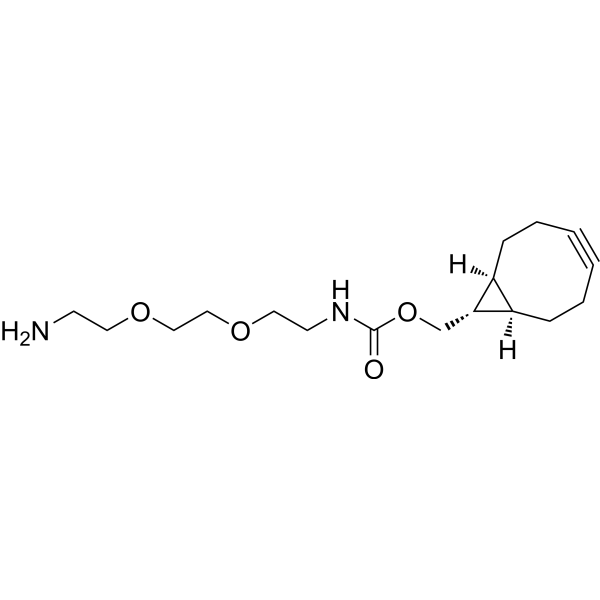
-
- HY-W096079
-
|
|
ADC Linker
|
Cancer
|
|
BCN-endo-PEG4-NHS is an ADC Linker containing 4 PEG units. BCN-endo-PEG4-NHS contains the lyophilic bidentate macrocyclic ligand endo-BCN, which allows for further synthesis of macrocyclic complexes. In click chemistry, endo-BCN can react with molecules containing azide groups to form stable triazoles in the absence of catalysts.
|
-

-
- HY-15739
-
-

-
- HY-N3509
-
|
(-)-Hyponine E
|
Others
|
Inflammation/Immunology
|
|
Hyponine E, a macrocyclic sesquiterpene pyridine alkaloid that could be isolated from from Tripterygium hypoglaucum, possesses anti-inflammatory effects .
|
-
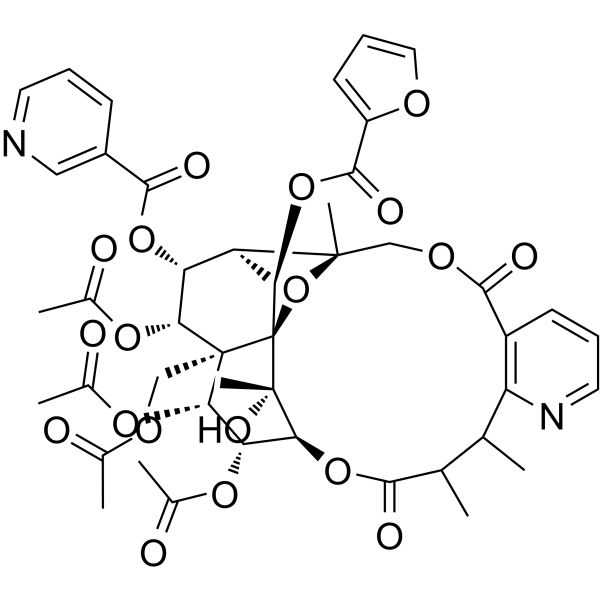
-
- HY-157977
-
|
|
Biochemical Assay Reagents
|
Others
|
|
DOTA-GA-maleimide is a macrocyclic chelator, which forms stable complex with metals. DOTA-GA-maleimide is utilized as radiolabelled imaging agent .
|
-
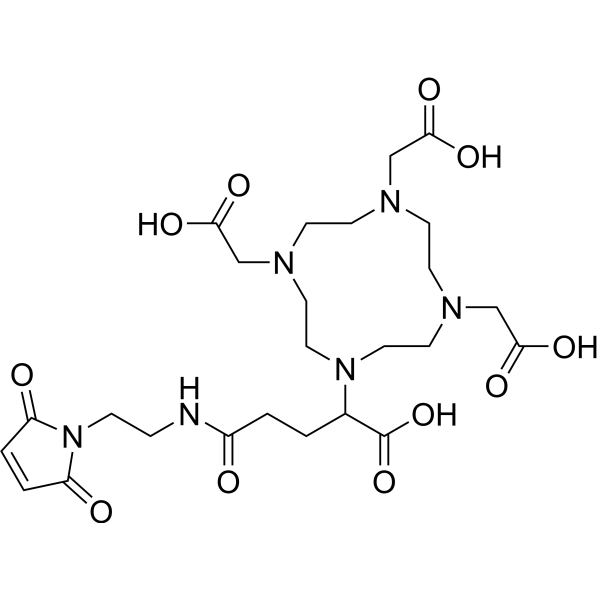
-
- HY-142948
-
|
|
Ras
|
Cancer
|
|
KRAS G12C inhibitor 46 (compound WX003) is a potent KRAS G12C inhibitor .
|
-

-
- HY-138134
-
|
|
Biochemical Assay Reagents
|
Others
|
|
NOTPis a bifunctional chelator (Bifunctional Chelator; BFC) and a macrocyclic NOTA derivative used for tumor pre-targeting. NOTP can be used for conjugation of peptides and radionuclides.
|
-
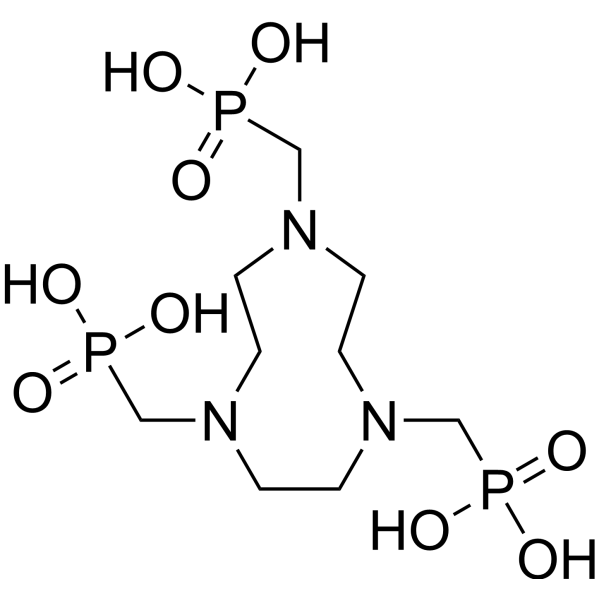
-
- HY-156310
-
|
|
ADC Linker
|
Cancer
|
|
BCN-endo-PEG7-NH2 is an ADC Linker containing 7 PEG units. BCN-endo-PEG7-NH2 contains the lyophilic bidentate macrocyclic ligand endo-BCN, which can further synthesize macrocyclic complexes. In click chemistry, endo-BCN can react with molecules containing azide groups to form stable triazoles in the absence of catalysts.
|
-
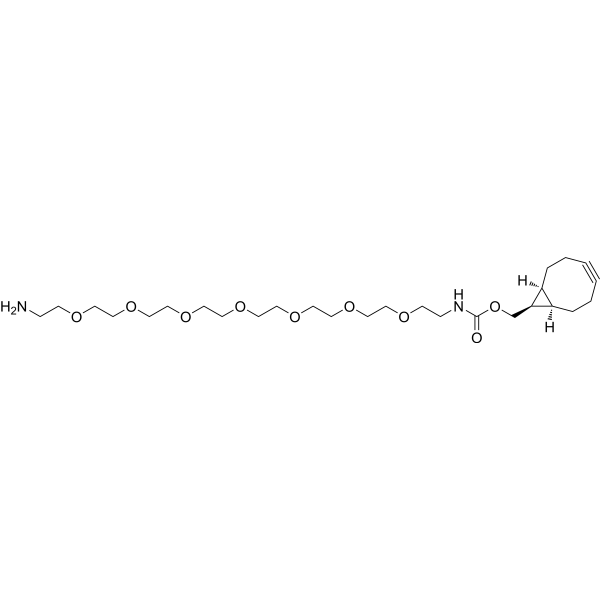
-
- HY-134418A
-
|
|
Biochemical Assay Reagents
|
Others
|
|
NOTA (trihydrochloride)is a bifunctional chelator (Bifunctional Chelator; BFC) and a macrocyclic NOTA derivative used for tumor pre-targeting. NOTA (trihydrochloride) can be used for conjugation of peptides and radionuclides.
|
-
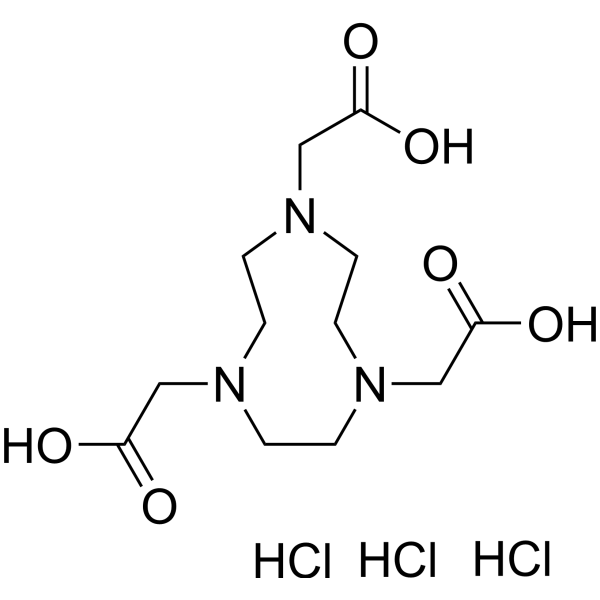
-
- HY-138269A
-
|
CHX-A''-DTPA-NCS hydrochloride
|
Biochemical Assay Reagents
|
Others
|
|
Barzuxetan (hydrochloride)is a bifunctional chelator (Bifunctional Chelator; BFC) and a macrocyclic DPTA derivative used for tumor pre-targeting. Barzuxetan (hydrochloride) can be used for conjugation of peptides and radionuclides.
|
-
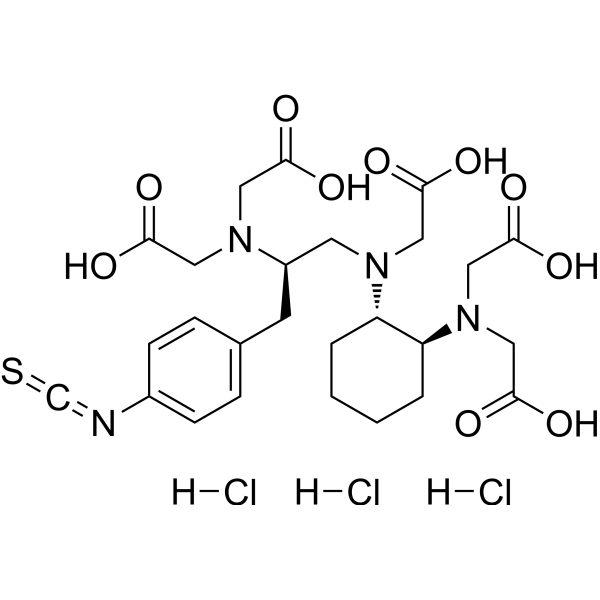
-
- HY-P3356
-
|
|
Elastase
Proteasome
|
Inflammation/Immunology
|
|
Cyclotheonellazole A is a natural macrocyclic peptide and a potent elastase inhibitor (IC50=0.034 nM). Cyclotheonellazole A inhibits chymotrypsin with an IC50 value of 0.62 nM .
|
-
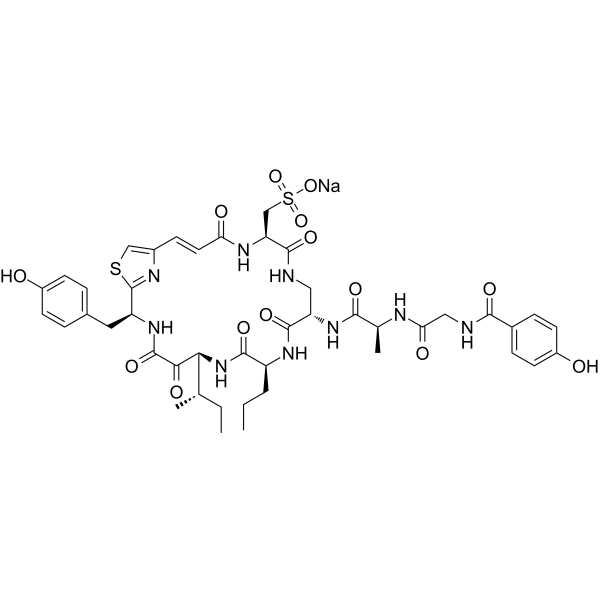
-
- HY-156105
-
|
|
Parasite
Proteasome
|
Infection
|
|
8304-vs is a macrocyclic anti-Plasmodial agent that covalently and irreversibly targets the Plasmodium proteasome. 8304-vs effectively inhibits the growth of Plasmodium falciparum .
|
-
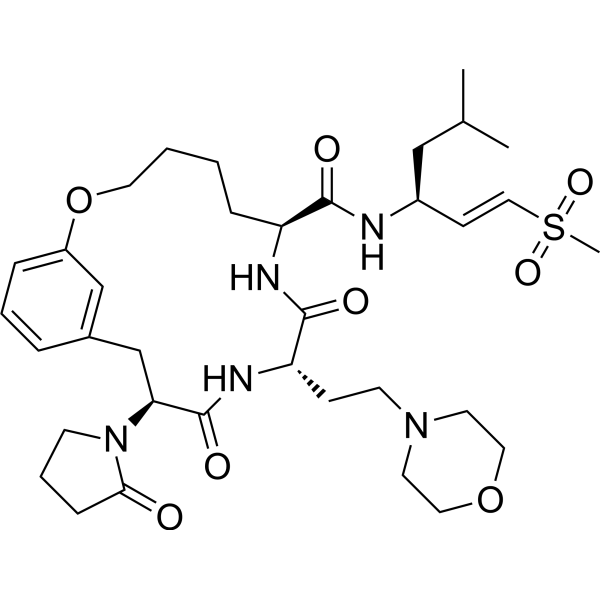
-
- HY-158067
-
|
DFO-DBCO
|
Biochemical Assay Reagents
|
Others
|
|
Deferoxamine-DBCOis a bifunctional chelator (Bifunctional Chelator; BFC) and a macrocyclic DFO derivative used for tumor pre-targeting. Deferoxamine-DBCO can be used for conjugation of peptides and radionuclides.
|
-

-
- HY-W088413
-
|
|
Biochemical Assay Reagents
|
Others
|
|
DOTA-amideis a bifunctional chelator (Bifunctional Chelator; BFC) and a macrocyclic DOTA derivative used for tumor pre-targeting. DOTA-amide can be used for conjugation of peptides and radionuclides.
|
-
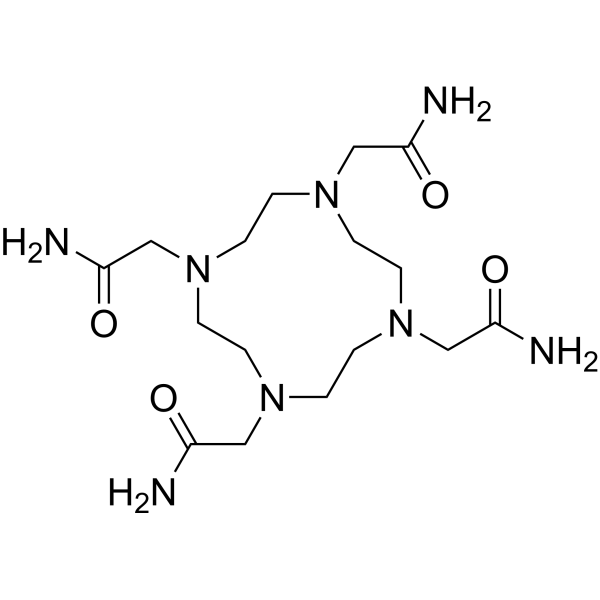
-
- HY-W782078
-
|
|
Biochemical Assay Reagents
|
Others
|
|
Butyne-DOTAis a bifunctional chelator (Bifunctional Chelator; BFC) and a macrocyclic DOTA derivative used for tumor pre-targeting. Butyne-DOTA can be used for conjugation of peptides and radionuclides.
|
-
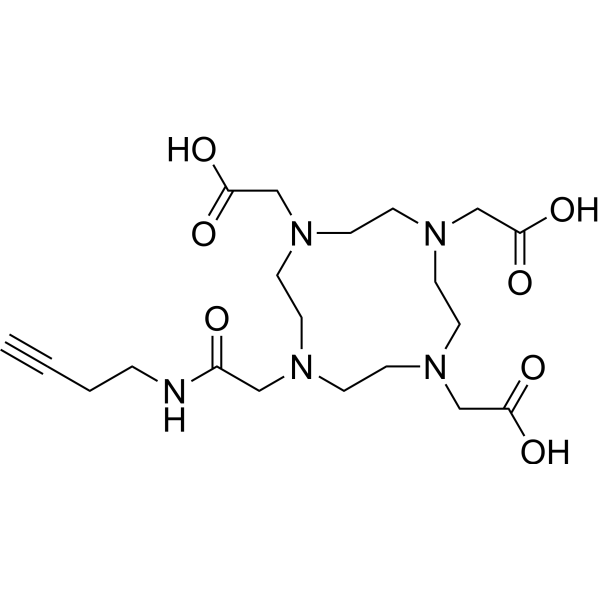
-
- HY-W678394
-
|
|
Biochemical Assay Reagents
|
Others
|
|
DOTA-Thiolis a bifunctional chelator (Bifunctional Chelator; BFC) and a macrocyclic DOTA derivative used for tumor pre-targeting. DOTA-Thiol can be used for conjugation of peptides and radionuclides.
|
-
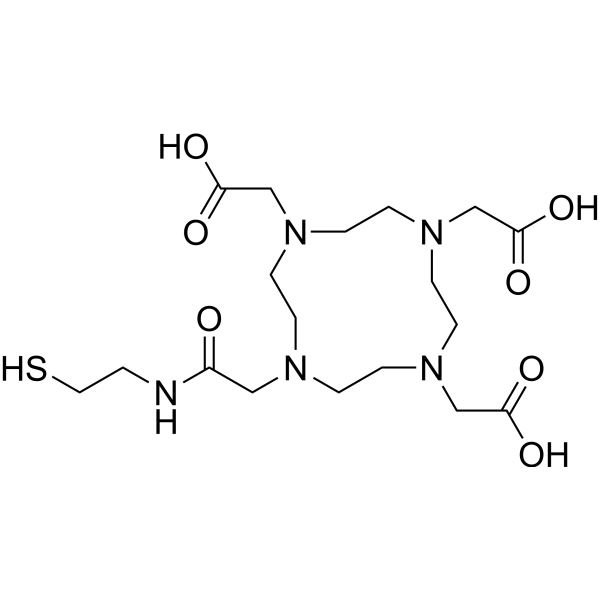
-
- HY-134734
-
|
|
ADC Linker
|
Cancer
|
|
BCN-exo-PEG7-maleimide is an ADC Linker containing 7 PEG units. BCN-exo-PEG7-maleimide contains the lyophilic bidentate macrocyclic ligand BCN, which allows for further synthesis of macrocyclic complexes. In click chemistry, BCN reacts with molecules containing azide groups to form stable triazoles in the absence of catalysts. Its maleimide group (-Maleimide) degrades in aqueous media and has been used in drug delivery studies.
|
-
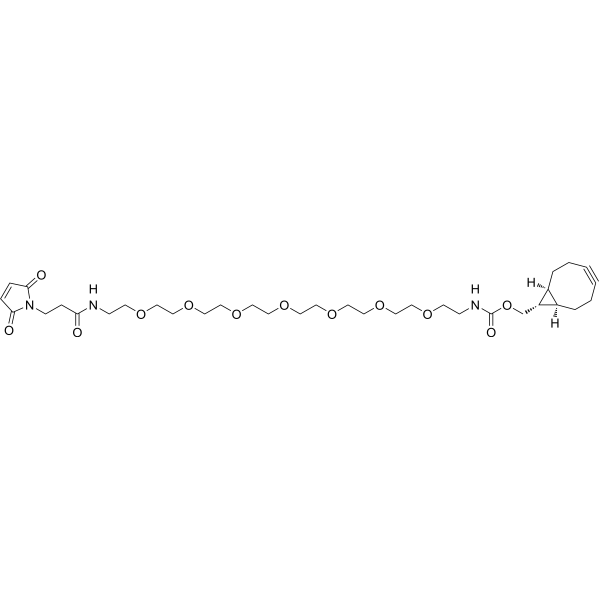
-
- HY-149620
-
|
|
Fluorescent Dye
|
Others
|
|
Cy5-PEG2-exo-BCN is a dye derivative of Cyanine 5 (Cy5) (HY-D0821) containing 2 PEG units. Cy5-PEG2-exo-BCN contains the lyophilic bidentate macrocyclic ligand BCN, which can further synthesize macrocyclic complexes. In click chemistry, BCN reacts with molecules containing azide groups to form stable triazoles in the absence of catalysts.
|
-
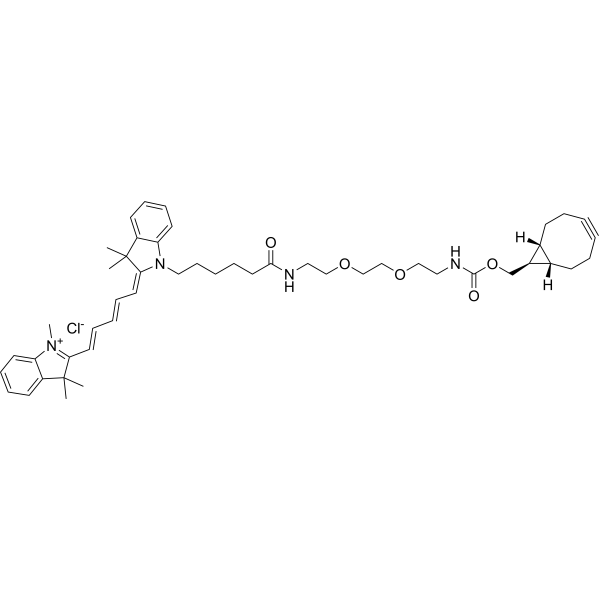
-
- HY-156320
-
|
|
ADC Linker
|
Cancer
|
|
BCN-exo-PEG2-maleimide is an ADC Linker containing 2 PEG units. BCN-exo-PEG2-maleimide contains the lyophilic bidentate macrocyclic ligand BCN, which allows for further synthesis of macrocyclic complexes. In click chemistry, BCN reacts with molecules containing azide groups to form stable triazoles in the absence of catalysts. Its maleimide group (-Maleimide) degrades in aqueous media and has been used in drug delivery studies.
|
-
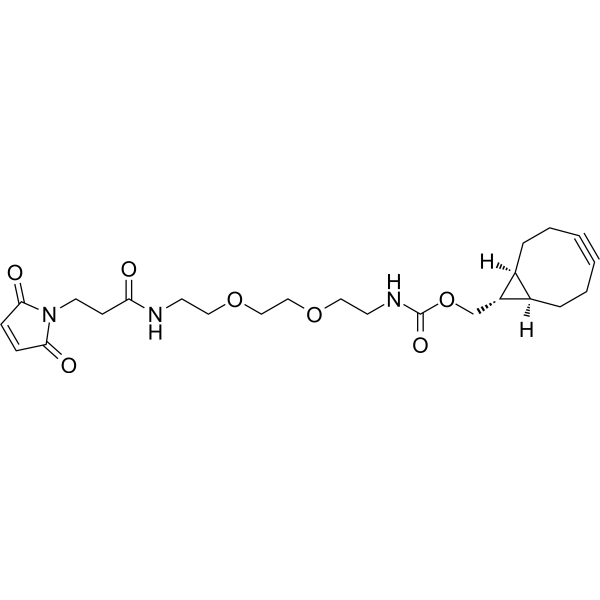
-
- HY-156322
-
|
|
ADC Linker
|
Cancer
|
|
BCN-exo-PEG3-maleimide is an ADC Linker containing 3 PEG units. BCN-exo-PEG3-maleimide contains the lyophilic bidentate macrocyclic ligand BCN, which enables the further synthesis of macrocyclic complexes. In click chemistry, BCN reacts with molecules containing azide groups to form stable triazoles in the absence of catalysts. Its maleimide group (-Maleimide) degrades in aqueous media and has been used in drug delivery studies.
|
-
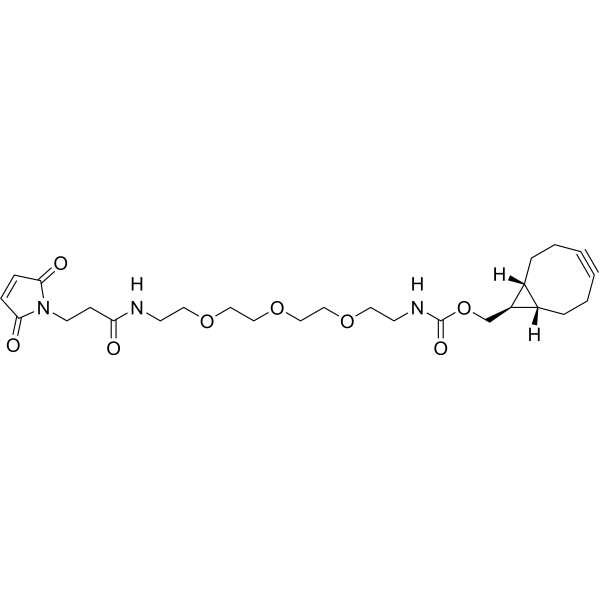
- HY-P3270
-
|
|
Bacterial
Antibiotic
|
Infection
|
|
Capreomycin is a macrocyclic peptide antibiotic. Capreomycin can be used for anti-multidrug-resistant-tuberculosis research. Capreomycin can inhibit phenylalanine synthesis in in mycobacterial ribosomes translation
|
-
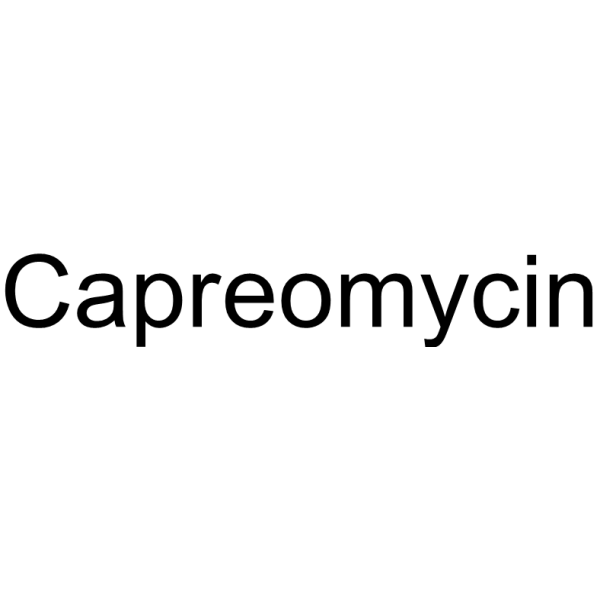
- HY-158072
-
|
|
Biochemical Assay Reagents
|
Others
|
|
DOTAM-NHS-esteris a bifunctional chelator (Bifunctional Chelator; BFC) and a macrocyclic DOTA derivative used for tumor pre-targeting. DOTAM-NHS-ester can be used for conjugation of peptides and radionuclides.
|
-
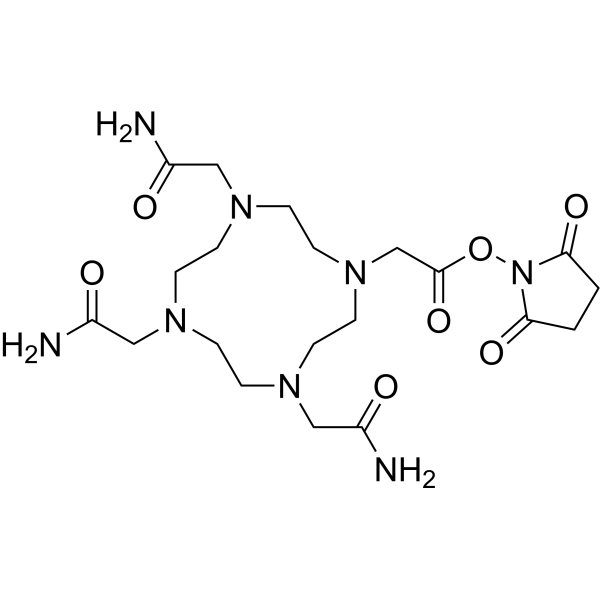
- HY-W717830
-
|
|
Biochemical Assay Reagents
|
Others
|
|
CB-Cyclamis a bifunctional chelator (Bifunctional Chelator; BFC), which is a main chain Cyclen derivative of the macrocyclic ligand tetradecane. CB-Cyclam can be used for conjugation of peptides and radionuclides.
|
-
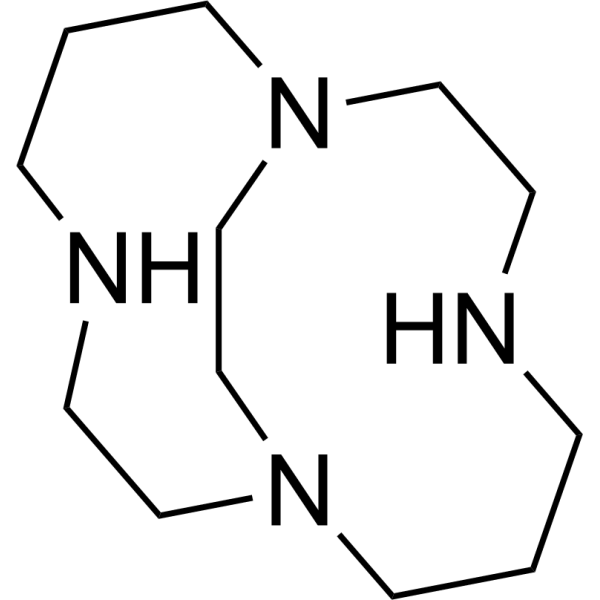
- HY-W717743
-
|
|
Biochemical Assay Reagents
|
Others
|
|
DOTAM-mono-acidis a bifunctional chelator (Bifunctional Chelator; BFC) and a macrocyclic DOTA derivative used for tumor pre-targeting. DOTAM-mono-acid can be used for conjugation of peptides and radionuclides.
|
-
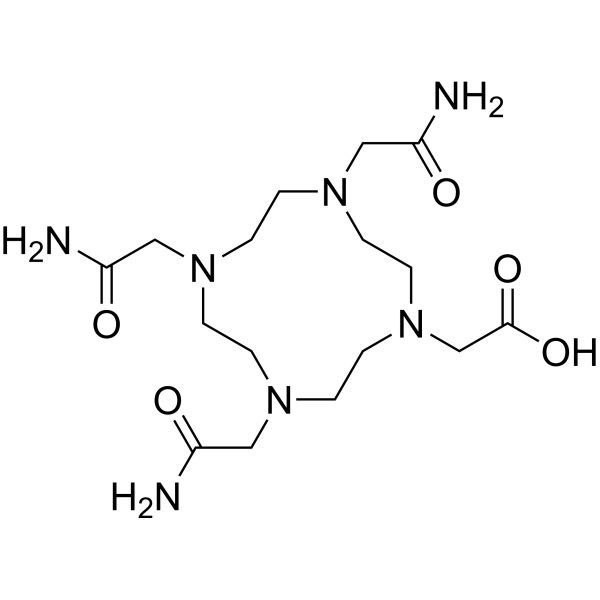
- HY-W726767
-
|
|
Biochemical Assay Reagents
|
Others
|
|
DO2Ais a bifunctional chelator (Bifunctional Chelator; BFC) and a macrocyclic DOTA derivative used for tumor pre-targeting. DO2A can be used for conjugation of peptides and radionuclides.
|
-
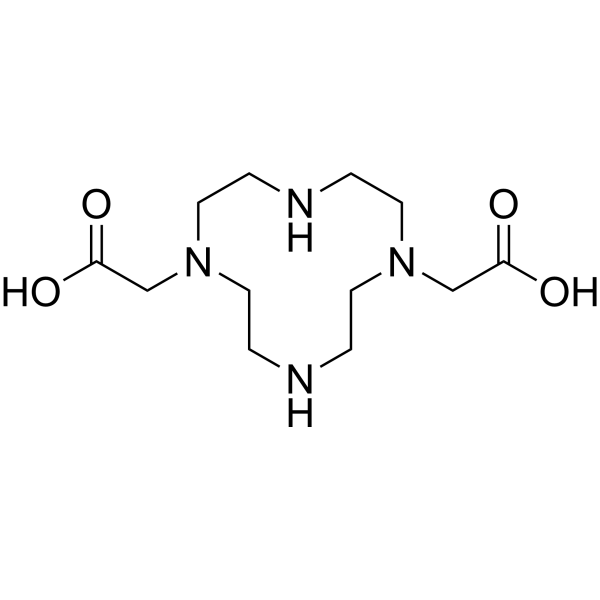
- HY-W717782
-
|
|
Biochemical Assay Reagents
|
Others
|
|
Bz-DTPA (hydrochloride)is a bifunctional chelator (Bifunctional Chelator; BFC) and a macrocyclic DPTA derivative used for tumor pre-targeting. Bz-DTPA (hydrochloride) can be used for conjugation of peptides and radionuclides.
|
-
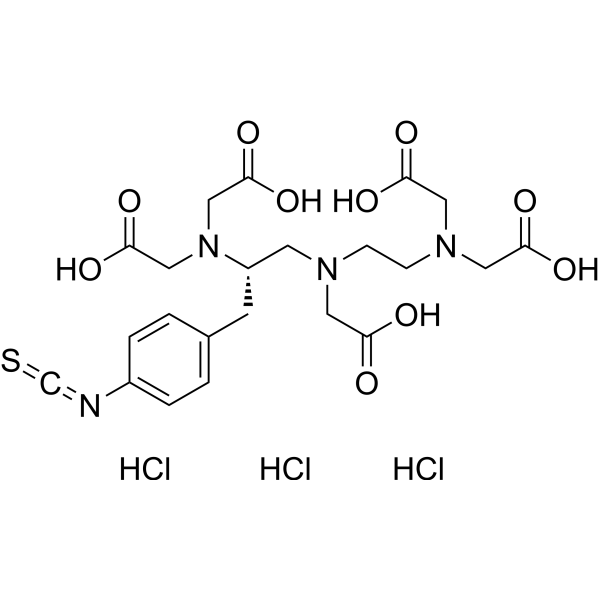
- HY-16217
-
|
ZK 135079
|
Biochemical Assay Reagents
|
Cancer
|
|
Gadobutrol (Gd-DO3A-butrol; ZK 135079) is a nonionic paramagnetic macrocyclic gadolinium-based contrast agent that can be used for magnetic resonance imaging (MRI) .
|
-
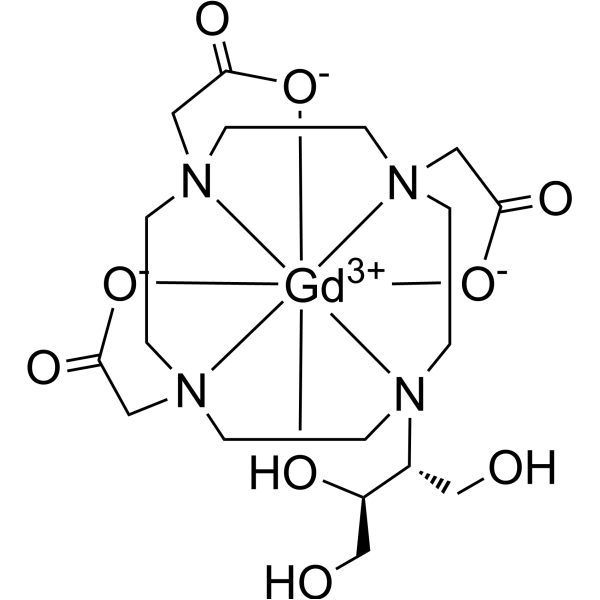
- HY-122402
-
|
|
Bacterial
|
Inflammation/Immunology
|
|
Umirolimus, a macrocyclic triene lactone Rapamycin derivative, is powerful immunosuppressant and anti-inflammatory agent. Umirolimus has highly lipophilicity and can be used agent-eluting stent (DES) applications .
|
-
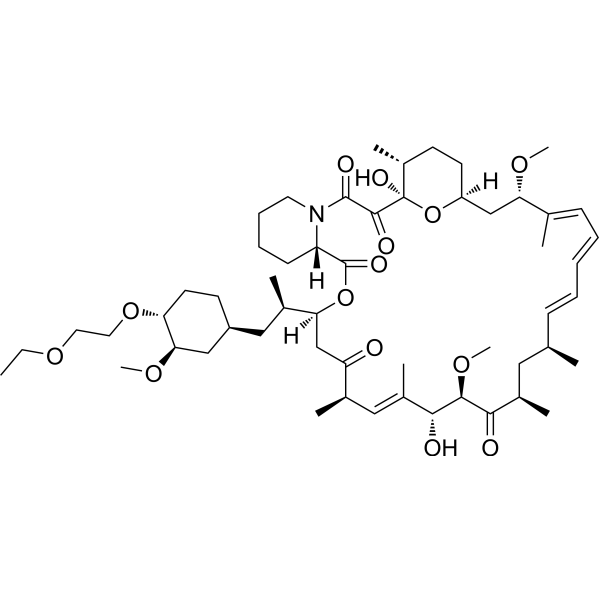
- HY-139105
-
|
|
Microtubule/Tubulin
|
Infection
Cancer
|
|
20-O-Demethyl-AP3 is a minor metabolite of Ansamitocin P-3. Ansamitocin P-3, a microtubule inhibitor, is a macrocyclic antitumor antibiotic .
|
-
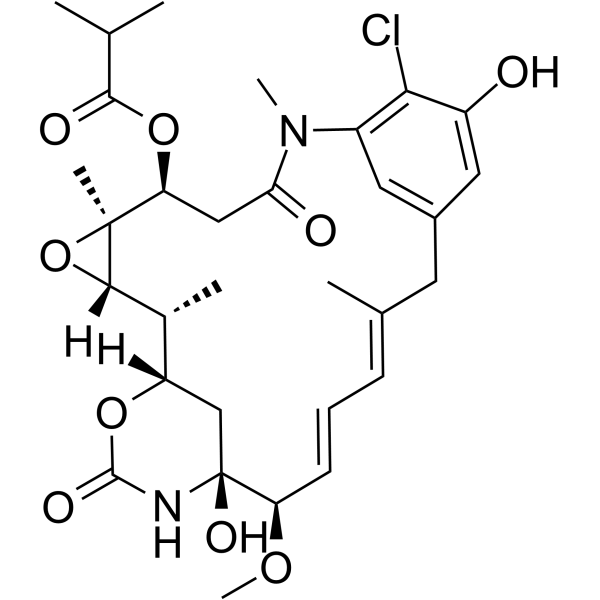
- HY-W087027A
-
|
|
Biochemical Assay Reagents
|
Others
|
|
Maleimide-NOTA (TFA)is a bifunctional chelator (Bifunctional Chelator; BFC) and a macrocyclic NOTA derivative used for tumor pre-targeting. Maleimide-NOTA (TFA) can be used for conjugation of peptides and radionuclides.
|
-
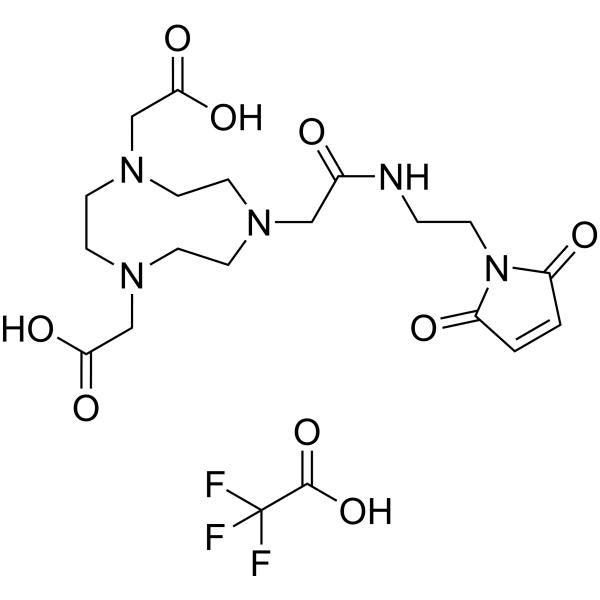
- HY-158077
-
|
(R)-tetraMe-DOTA
|
Biochemical Assay Reagents
|
Others
|
|
(R)-tetraMe-Tetraxetanis a bifunctional chelator (Bifunctional Chelator; BFC) and a macrocyclic DOTA derivative used for tumor pre-targeting. (R)-tetraMe-Tetraxetan can be used for conjugation of peptides and radionuclides.
|
-
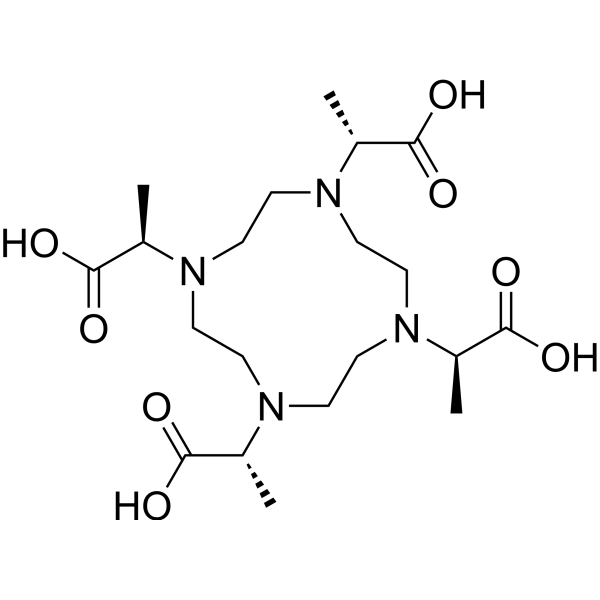
- HY-W250844A
-
|
|
Biochemical Assay Reagents
|
Others
|
|
DO3A (trisodium)is a bifunctional chelator (Bifunctional Chelator; BFC) and a macrocyclic DOTA derivative used for tumor pre-targeting. DO3A (trisodium) can be used for conjugation of peptides and radionuclides.
|
-
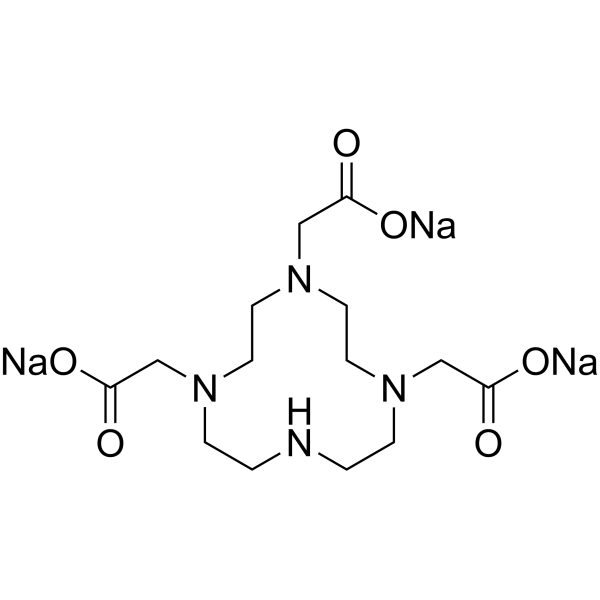
- HY-149618
-
|
|
Fluorescent Dye
|
Others
|
|
Cy5-PEG3-endo-BCN is a dye derivative of Cyanine 5 (Cy5) (HY-D0821) containing 3 PEG units. Cy5-PEG3-endo-BCN contains the lyophilic bidentate macrocyclic ligand endo-BCN, which can further synthesize macrocyclic complexes. In click chemistry, endo-BCN can react with molecules containing azide groups to form stable triazoles in the absence of catalysts.
|
-
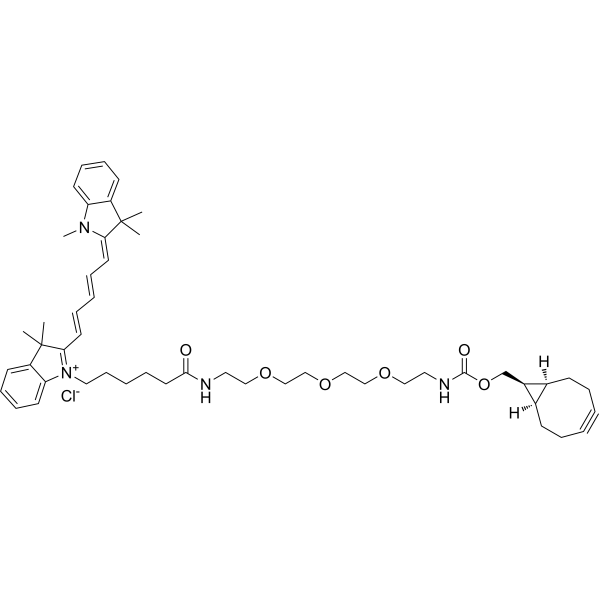
- HY-149619
-
|
|
Fluorescent Dye
|
Others
|
|
Cy5-PEG7-endo-BCN is a dye derivative of Cyanine 5 (Cy5) (HY-D0821) containing 7 PEG units. Cy5-PEG7-endo-BCN contains the lyophilic bidentate macrocyclic ligand endo-BCN, which can further synthesize macrocyclic complexes. In click chemistry, endo-BCN can react with molecules containing azide groups to form stable triazoles in the absence of catalysts.
|
-
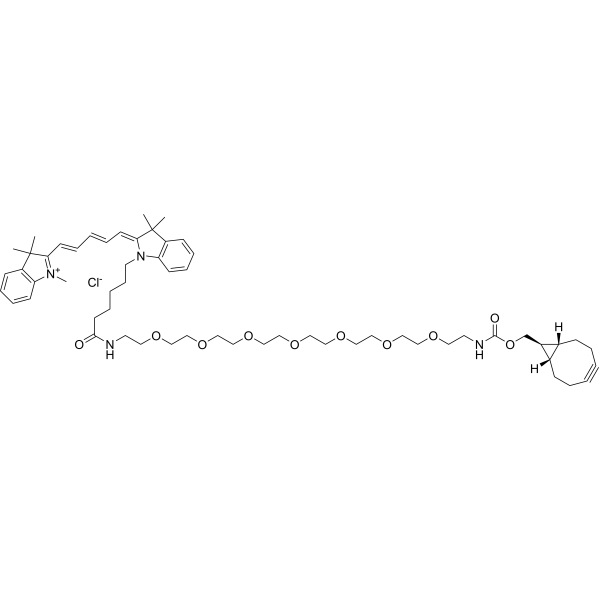
- HY-155327
-
|
|
Fluorescent Dye
|
Others
|
|
Cy3-PEG2-endo-BCN is a dye derivative of Cyanine 3 (Cy3) (HY-D0822) containing 2 PEG units. Cy3-PEG2-endo-BCN contains the lyophilic bidentate macrocyclic ligand endo-BCN, which can further synthesize macrocyclic complexes. In click chemistry, endo-BCN can react with molecules containing azide groups to form stable triazoles in the absence of catalysts.
|
-
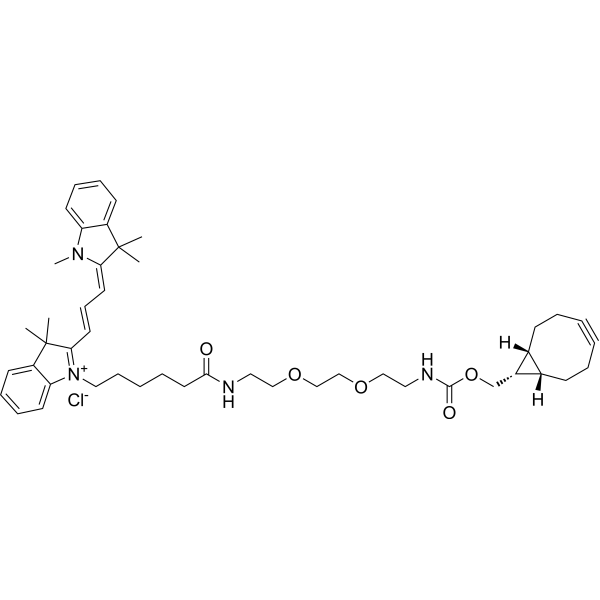
- HY-156311
-
|
|
ADC Linker
|
Cancer
|
|
BCN-endo-PEG2-maleimide is an ADC Linker containing 4 PEG units. BCN-endo-PEG2-maleimide contains the lyophilic bidentate macrocyclic ligand endo-BCN, which can further synthesize macrocyclic complexes. In click chemistry, endo-BCN can react with molecules containing azide groups to form stable triazoles in the absence of catalysts. Its maleimide group (-Maleimide) degrades in aqueous media and has been used in drug delivery studies.
|
-
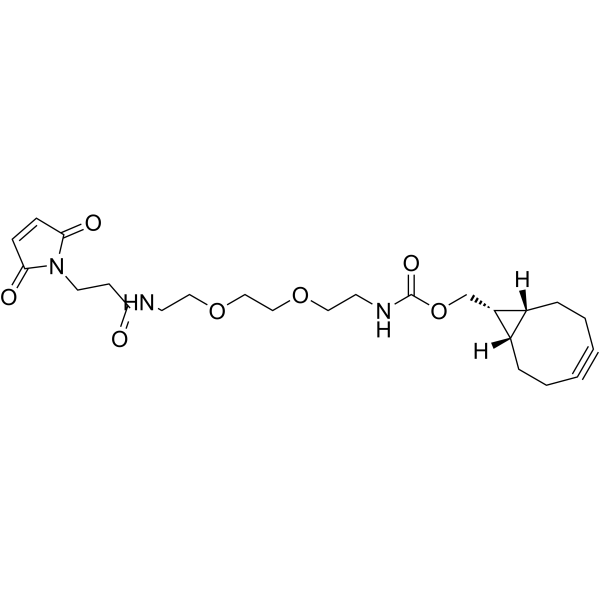
- HY-W539916
-
|
|
Biochemical Assay Reagents
|
Others
|
|
Azido-mono-amide-DOTAis a bifunctional chelator (Bifunctional Chelator; BFC) and a macrocyclic DOTA derivative used for tumor pre-targeting. Azido-mono-amide-DOTA can be used for conjugation of peptides and radionuclides.
|
-
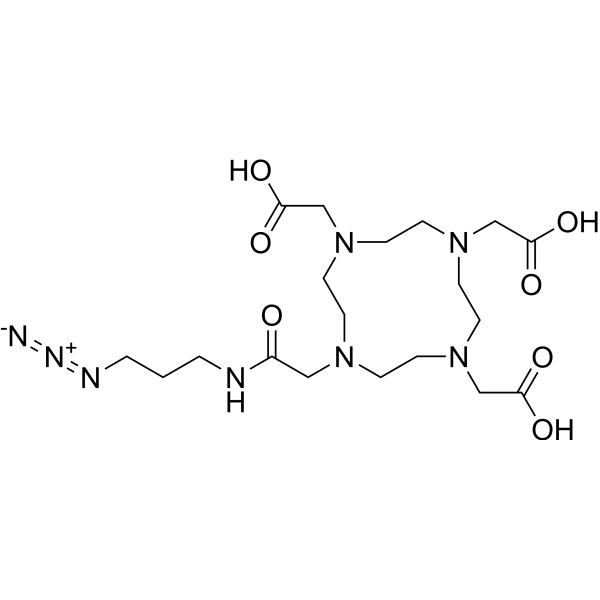
- HY-158071
-
|
|
Biochemical Assay Reagents
|
Others
|
|
p-SCN-Bn-HEHA (hydrochloride)is a bifunctional chelator (Bifunctional Chelator; BFC) and a macrocyclic DPTA derivative used for tumor pre-targeting. p-SCN-Bn-HEHA (hydrochloride) can be used for drug conjugation.
|
-
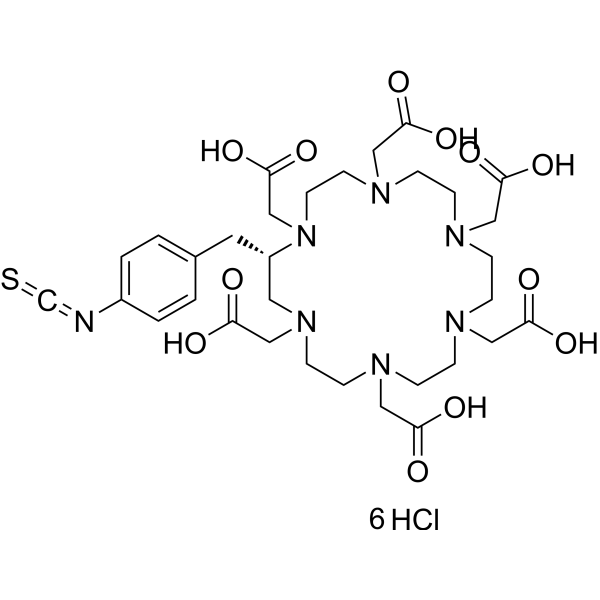
- HY-128890A
-
|
|
Biochemical Assay Reagents
|
Others
|
|
DOTA-NHS-ester (hexafluorophosphate TFA)is a bifunctional chelator (Bifunctional Chelator; BFC) and a macrocyclic DOTA derivative used for tumor pre-targeting. DOTA-NHS-ester (hexafluorophosphate TFA) can be used for conjugation of peptides and radionuclides.
|
-
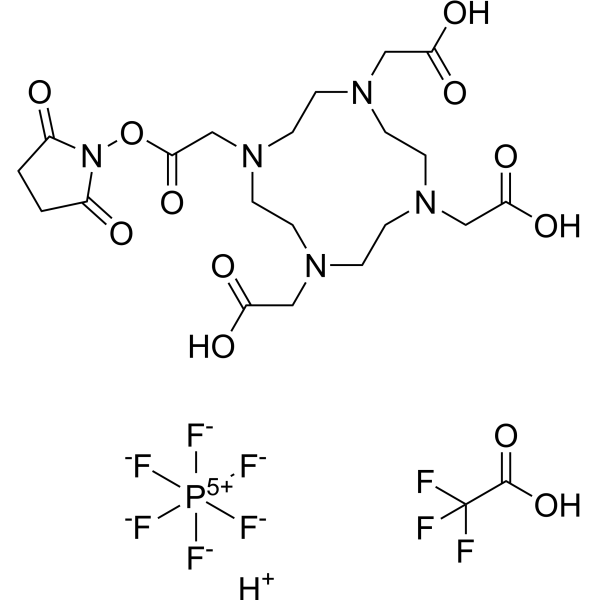
- HY-W717779
-
|
|
Biochemical Assay Reagents
|
Others
|
|
4-Aminobutyl-DOTAis a bifunctional chelator (Bifunctional Chelator; BFC) and a macrocyclic DOTA derivative used for tumor pre-targeting. 4-Aminobutyl-DOTA can be used for conjugation of peptides and radionuclides.
|
-
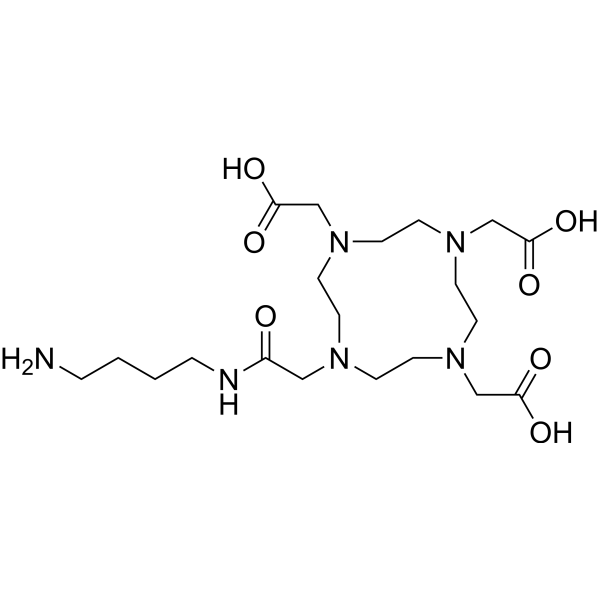
- HY-145263
-
|
|
Ser/Thr Protease
|
Cancer
|
|
VD2173 is a side chain cyclized macrocyclic peptide inhibitor of HGF-activating serine proteases. VD2173 potently inhibits matriptase and hepsin. VD2173 can be used for the research of lung cancer .
|
-
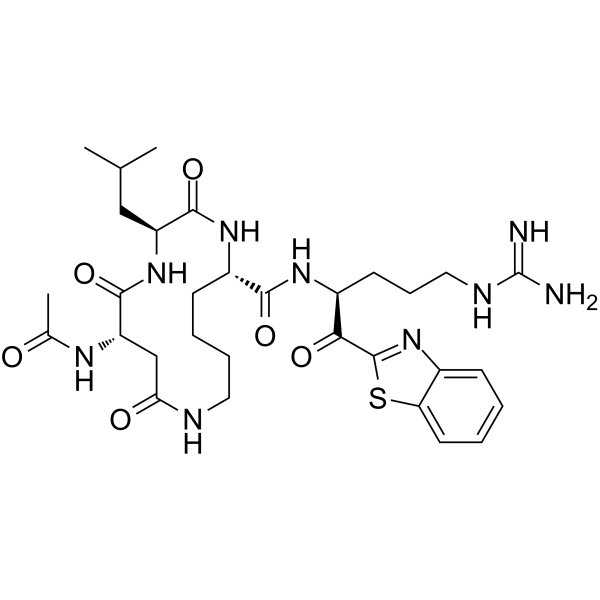
- HY-A0074
-
|
tetra-tBu-DTPA
|
Biochemical Assay Reagents
|
Others
|
|
DTPA-tetra (t-Bu ester)is a bifunctional chelator (Bifunctional Chelator; BFC) and a macrocyclic DPTA derivative used for tumor pre-targeting. DTPA-tetra (t-Bu ester) can be used for conjugation of peptides and radionuclides.
|
-
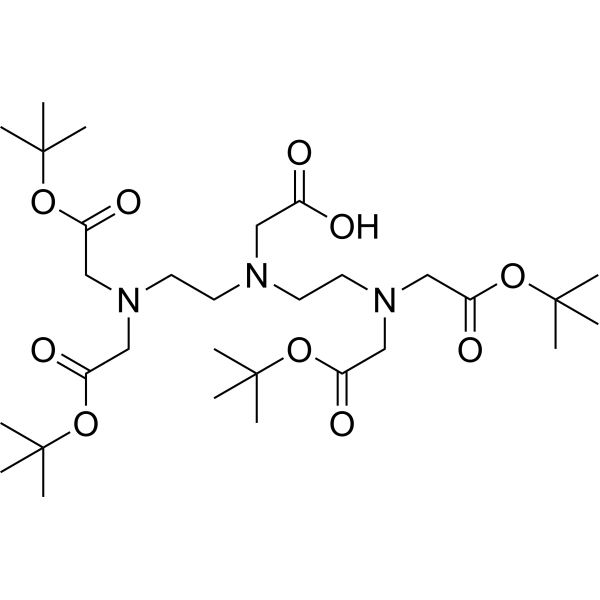
- HY-W717781A
-
|
|
Biochemical Assay Reagents
|
Others
|
|
p-NH?-Bn-DTPA (hydrochloride)is a bifunctional chelator (Bifunctional Chelator; BFC) and a macrocyclic DPTA derivative used for tumor pre-targeting. p-NH?-Bn-DTPA (hydrochloride) can be used for conjugation of peptides and radionuclides.
|
-
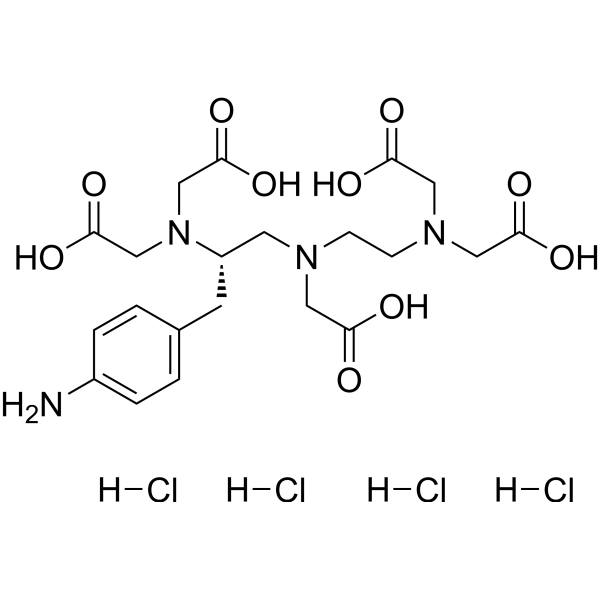
- HY-W782088A
-
|
|
Biochemical Assay Reagents
|
Others
|
|
p-NH?-Bn-PCTA (hydrochloride)is a bifunctional chelator (Bifunctional Chelator; BFC) and a macrocyclic DPTA derivative used for tumor pre-targeting. p-NH?-Bn-PCTA (hydrochloride) can be used for conjugation of peptides and radionuclides.
|
-
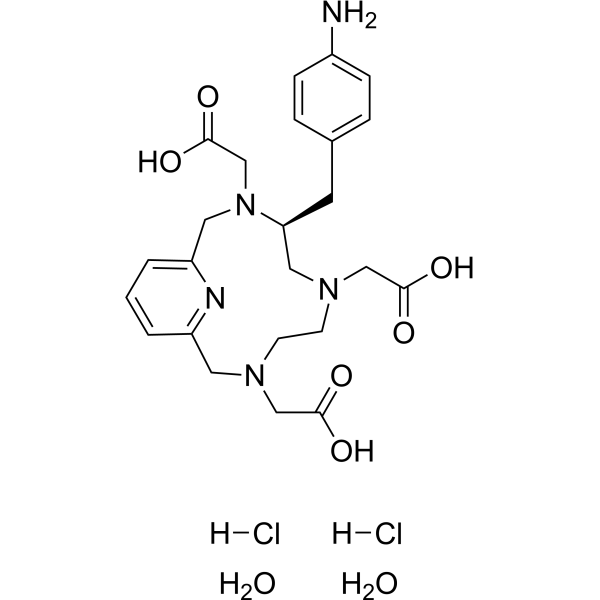
- HY-W782087A
-
|
|
Biochemical Assay Reagents
|
Others
|
|
p-SCN-Bn-PCTA (hydrochloride)is a bifunctional chelator (Bifunctional Chelator; BFC) and a macrocyclic DPTA derivative used for tumor pre-targeting. p-SCN-Bn-PCTA (hydrochloride) can be used for conjugation of peptides and radionuclides.
|
-

- HY-W782083
-
|
|
Biochemical Assay Reagents
|
Others
|
|
p-SCN-Bn-NOTA (trihydrochloride)is a bifunctional chelator (Bifunctional Chelator; BFC) and a macrocyclic NOTA derivative used for tumor pre-targeting. p-SCN-Bn-NOTA (trihydrochloride) can be used for conjugation of peptides and radionuclides.
|
-
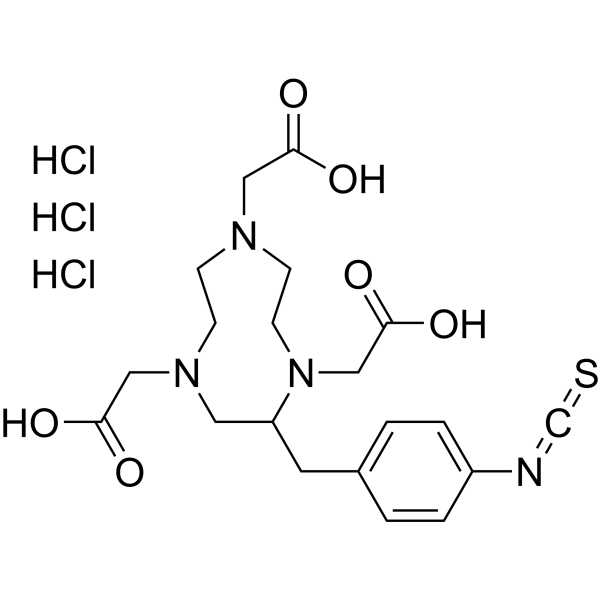
- HY-156038
-
|
|
Biochemical Assay Reagents
|
Others
|
|
(S)-p-SCN-Bn-DOTAis a bifunctional chelator (Bifunctional Chelator; BFC) and a macrocyclic DOTA derivative used for tumor pre-targeting. (S)-p-SCN-Bn-DOTA can be used for conjugation of peptides and radionuclides.
|
-
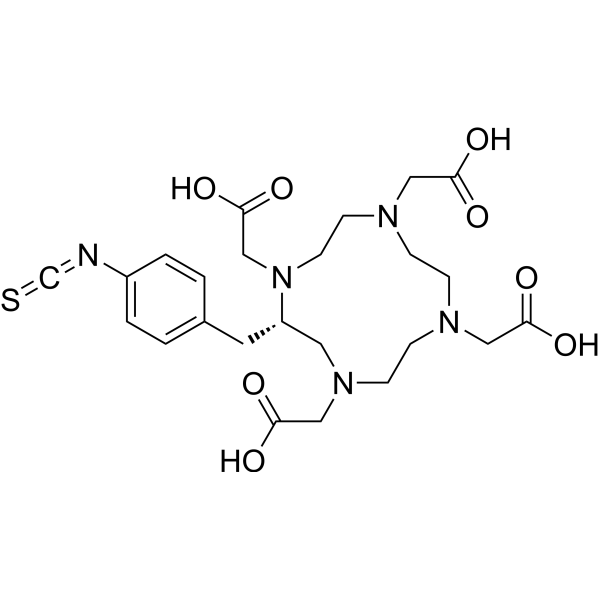
- HY-W749627
-
|
|
Biochemical Assay Reagents
|
Others
|
|
NO2A-Butyneis a bifunctional chelator (Bifunctional Chelator; BFC) and a macrocyclic NOTA derivative used for tumor pre-targeting. NO2A-Butyne can be used for conjugation of peptides and radionuclides.
|
-

- HY-158068
-
|
|
Biochemical Assay Reagents
|
Others
|
|
Maleimido-mono-amide-DTPA (TFA)is a bifunctional chelator (Bifunctional Chelator; BFC) and a macrocyclic DPTA derivative used for tumor pre-targeting. Maleimido-mono-amide-DTPA (TFA) can be used for conjugation of peptides and radionuclides.
|
-
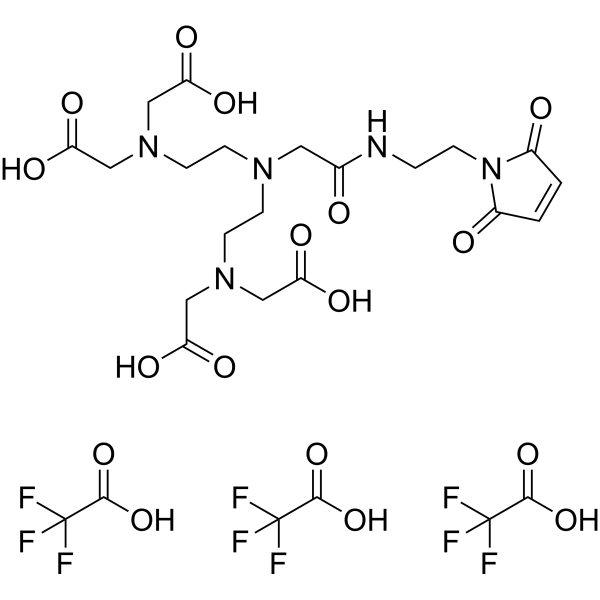
- HY-W802013
-
|
|
Biochemical Assay Reagents
|
Others
|
|
DOTA-4AMPis a bifunctional chelator (Bifunctional Chelator; BFC) and a macrocyclic DOTA derivative used for tumor pre-targeting. DOTA-4AMP can be used for conjugation of peptides and radionuclides.
|
-
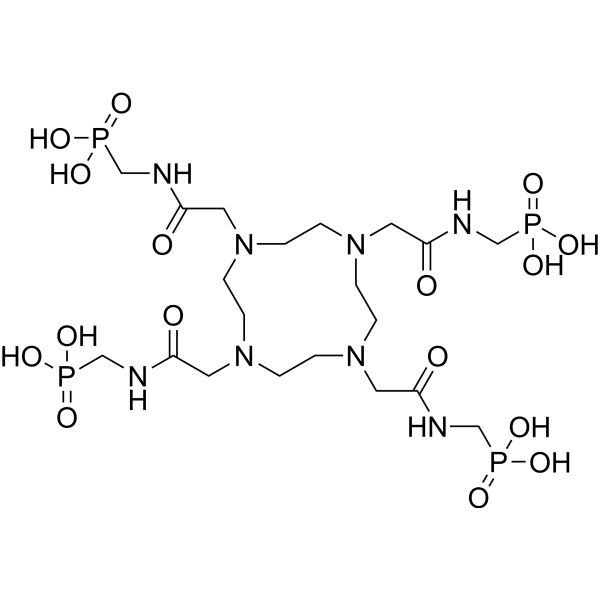
- HY-P3502A
-
|
RA101495 TFA; RA3193 TFA
|
Complement System
|
Inflammation/Immunology
|
|
Zilucoplan TFA (RA101495), a 15-amino acid macrocyclic peptide, is a potent complement component 5 (C5) inhibitor. Zilucoplan TFA can be used in research of immune-mediated necrotising myopathy (IMNM) .
|
-
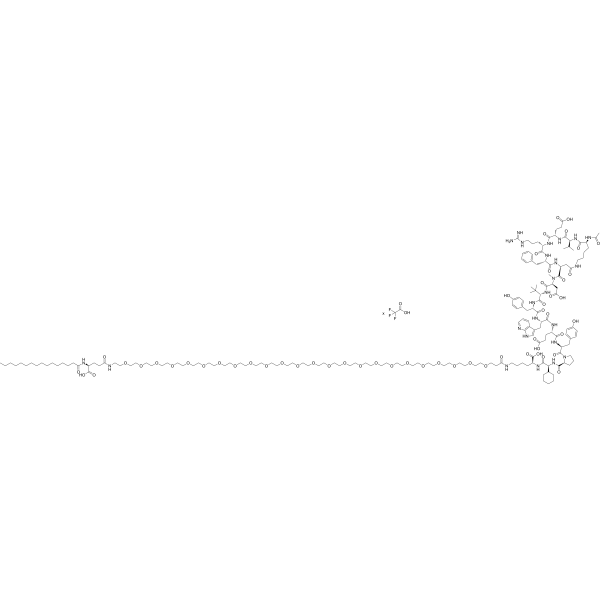
- HY-P5753A
-
|
|
Bacterial
|
Infection
|
|
JB-95 acetate, a β-hairpin macrocyclic peptide, exhibits potent antimicrobial activity against Escherichia coli. JB-95 acetate can selectively disrupt the outer membrane but not the inner membrane of E. coli .
|
-
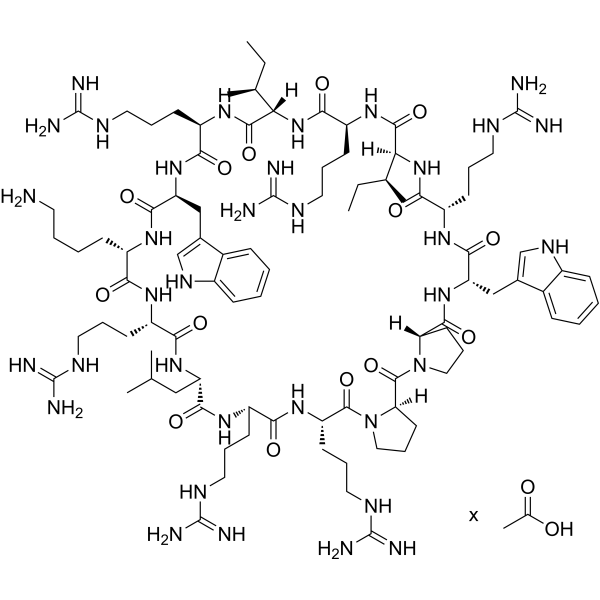
- HY-P5753
-
|
|
Bacterial
|
Infection
|
|
JB-95, a β-hairpin macrocyclic peptide, exhibits potent antimicrobial activity against Escherichia coli. JB-95 can selectively disrupt the outer membrane but not the inner membrane of E. coli .
|
-
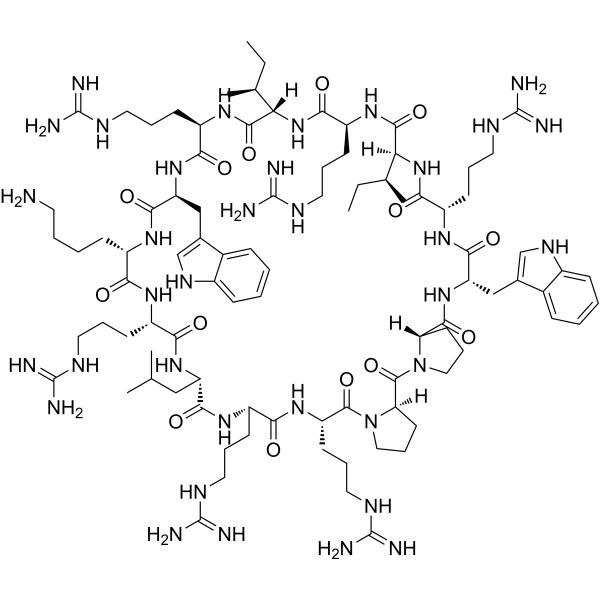
- HY-131673A
-
|
|
Biochemical Assay Reagents
|
Others
|
|
(S)-p-SCN-Bn-TCMC (hydrochloride)is a bifunctional chelator (Bifunctional Chelator; BFC) and a macrocyclic DOTA derivative used for tumor pre-targeting. (S)-p-SCN-Bn-TCMC (hydrochloride) can be used for conjugation of peptides and radionuclides.
|
-
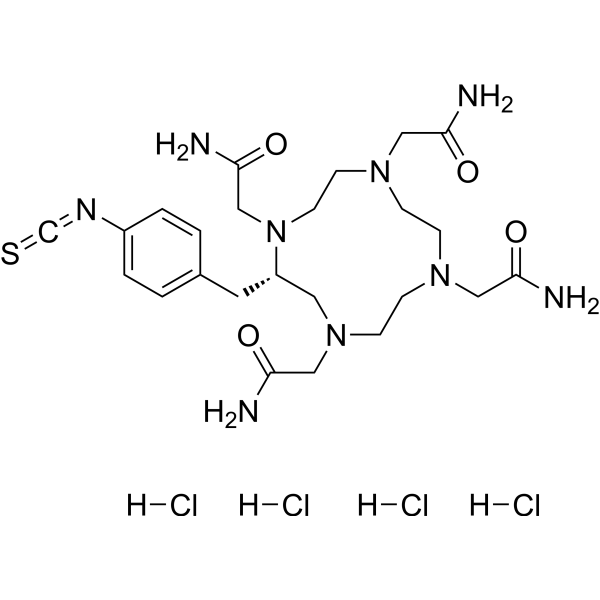
- HY-W451440
-
|
|
Biochemical Assay Reagents
|
Others
|
|
Butyne-DOTA-tris(t-butyl ester)is a bifunctional chelator (Bifunctional Chelator; BFC) and a macrocyclic DOTA derivative used for tumor pre-targeting. Butyne-DOTA-tris(t-butyl ester) can be used for conjugation of peptides and radionuclides.
|
-
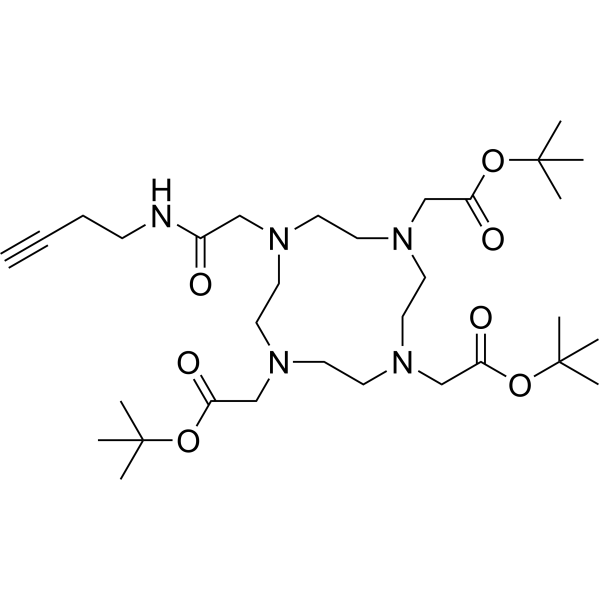
- HY-W717800A
-
|
|
Biochemical Assay Reagents
|
Others
|
|
NO2A-Azide (trihydrochloride)is a bifunctional chelator (Bifunctional Chelator; BFC) and a macrocyclic NOTA derivative used for tumor pre-targeting. NO2A-Azide (trihydrochloride) can be used for conjugation of peptides and radionuclides.
|
-
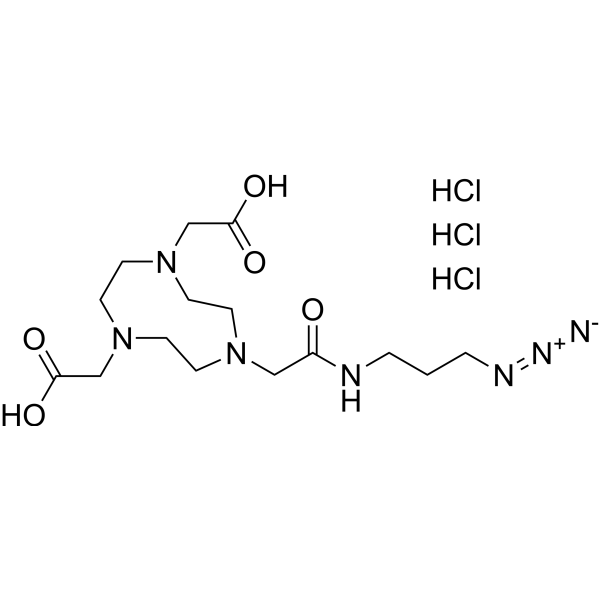
- HY-13756A
-
|
FK506 monohydrate; Fujimycin monohydrate; FR900506 monohydrate
|
Phosphatase
FKBP
Autophagy
Bacterial
Antibiotic
|
Infection
Inflammation/Immunology
Cancer
|
|
Tacrolimus monohydrate (FK506 monohydrate), a macrocyclic lactone, binds to FK506 binding protein (FKBP) to form a complex and inhibits calcineurin phosphatase, which inhibits T-lymphocyte signal transduction and IL-2 transcription. Immunosuppressive properties .
|
-
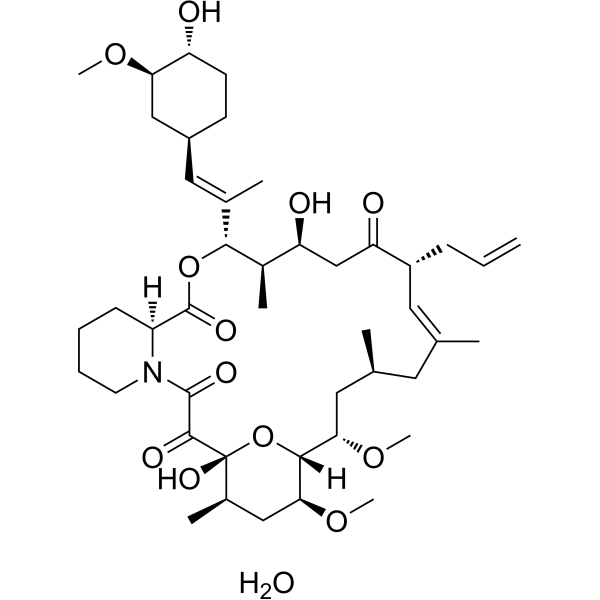
- HY-156138A
-
|
|
Biochemical Assay Reagents
|
Others
|
|
CB-TE2A (tetrahydrochloride)is a bifunctional chelator (Bifunctional Chelator; BFC), which is a TETA derivative of the macrocyclic ligand tetradecane backbone. CB-TE2A (tetrahydrochloride) can be used for conjugation of peptides and radionuclides.
|
-
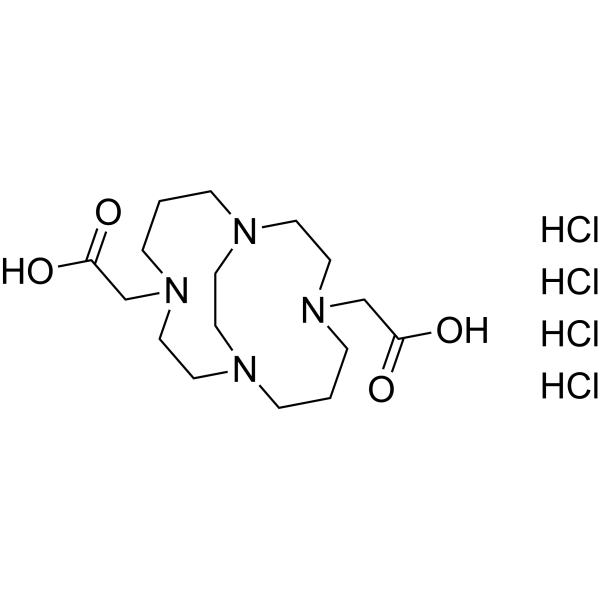
- HY-13756
-
-
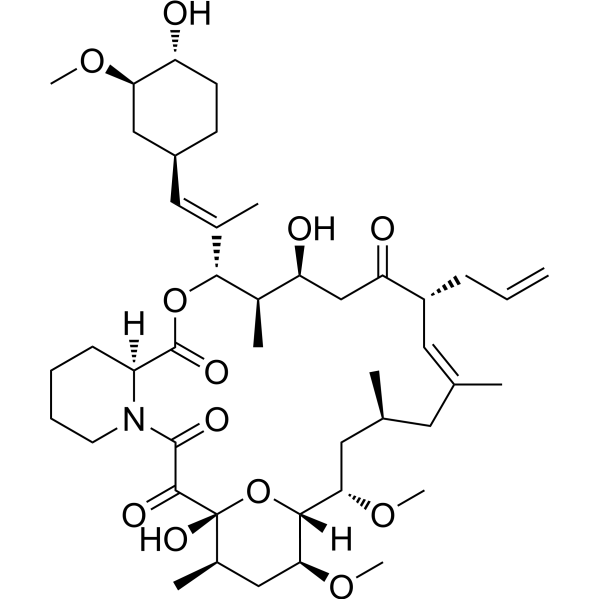
- HY-W717833
-
|
|
Biochemical Assay Reagents
|
Others
|
|
NO2A-(t-Bu ester)is a bifunctional chelator (Bifunctional Chelator; BFC) and a macrocyclic NOTA derivative used for tumor pre-targeting. NO2A-(t-Bu ester) can be used for conjugation of peptides and radionuclides.
|
-
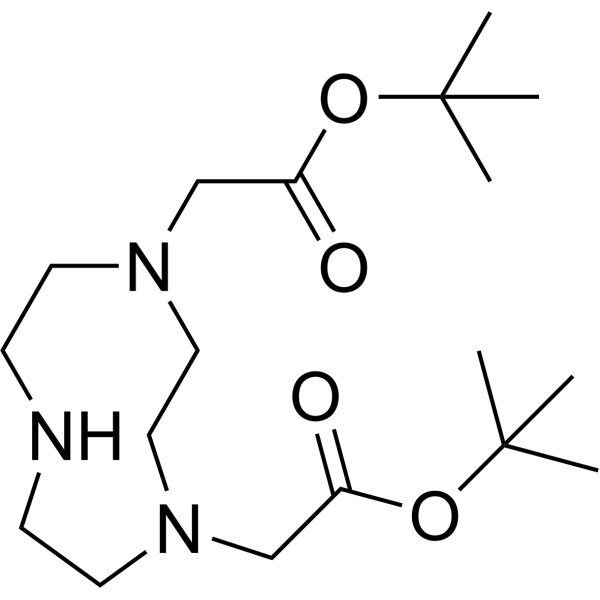
- HY-151382
-
|
|
Casein Kinase
|
Cancer
|
|
CK2-IN-3 is a selective and potent CK2 inhibitor (Kd: 12 nM), with IC50 values of 1.51 μM (CK2α) and 7.64 μM (CK2α’). CK2-IN-3 can be used in the research of cancers .
|
-
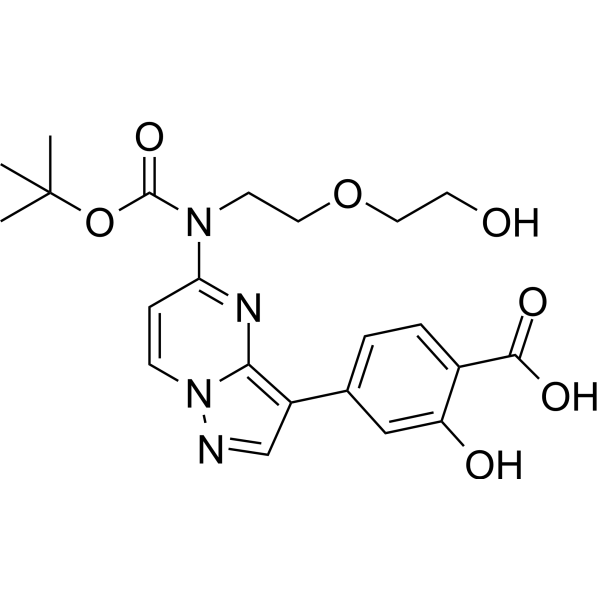
- HY-W717742
-
|
|
Biochemical Assay Reagents
|
Others
|
|
p-NO2-Bn-Cyclenis a bifunctional chelator (Bifunctional Chelator; BFC), which is a derivative of the macrocyclic ligand dodecane backbone Cyclen. p-NO2-Bn-Cyclen can be used for conjugation of peptides and radionuclides.
|
-
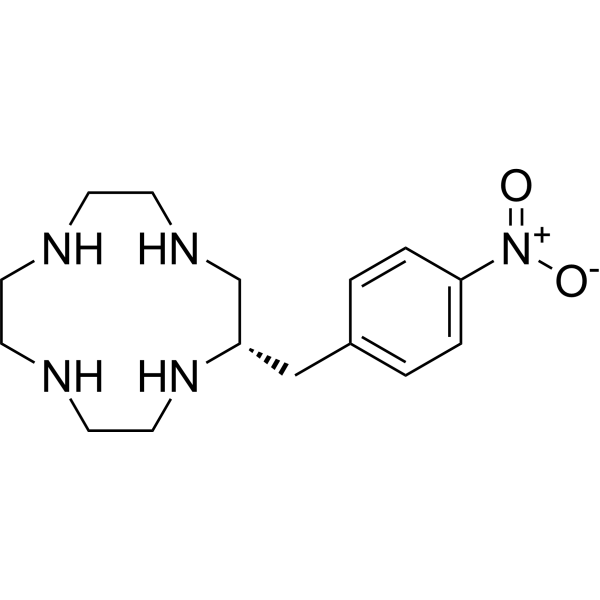
- HY-48876
-
|
|
Biochemical Assay Reagents
|
Others
|
|
p-NH2-Bn-DOTAis a bifunctional chelator (Bifunctional Chelator; BFC) and a macrocyclic DOTA derivative used for tumor pre-targeting. p-NH2-Bn-DOTA can be used for conjugation of peptides and radionuclides.
|
-
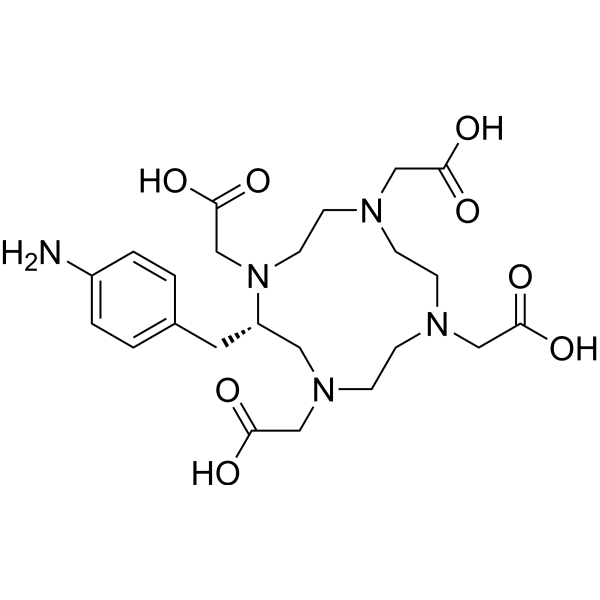
- HY-W782075
-
|
|
Biochemical Assay Reagents
|
Others
|
|
p-NO2-Bn-DOTAis a bifunctional chelator (Bifunctional Chelator; BFC) and a macrocyclic DOTA derivative used for tumor pre-targeting. p-NO2-Bn-DOTA can be used for conjugation of peptides and radionuclides.
|
-
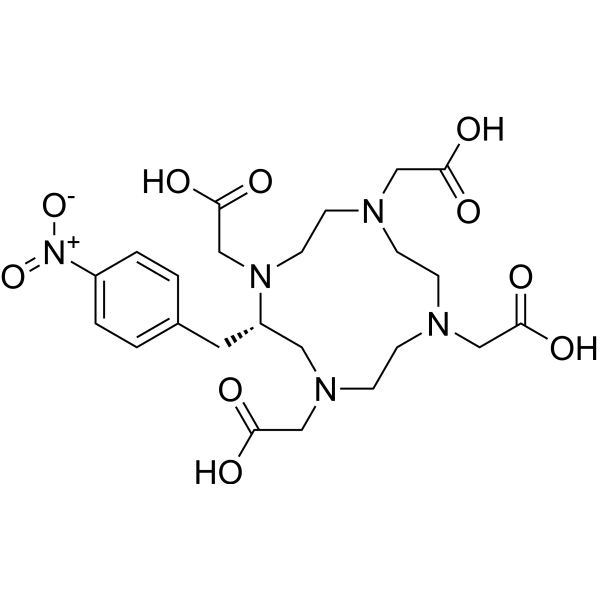
- HY-N6686
-
|
Pristinamycin IIA; Ostreogrycin A
|
Bacterial
Antibiotic
|
Infection
|
|
Virginiamycin M1 (Pristinamycin IIA; Ostreogrycin A), produced by Streptomyces virginiae, is an polyunsaturated macrocyclic lactone antibiotic and acts as a component of Virginiamycin (HY-112665) . Virginiamycin M1 alone is against Staphylococcus aureus with a MIC of 0.25 μg/mL.
|
-

- HY-148465
-
|
|
Biochemical Assay Reagents
|
Cardiovascular Disease
Cancer
|
|
Gadoteric acid is a macrocyclic, paramagnetic, gadolinium-based contrast agent that can be used for magnetic resonance imaging (MRI) of the brain, spine, and related tissues. In particular, Gadoteric acid is able to detect and visualize areas of blood-brain barrier disruption and abnormal vascular distribution .
|
-
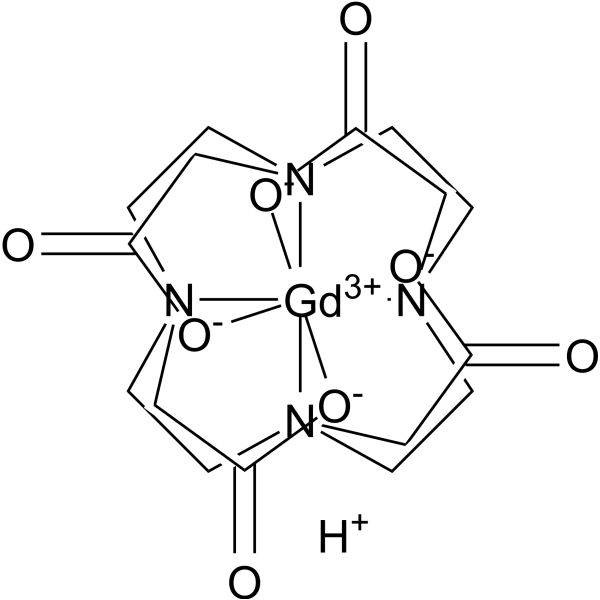
- HY-158066
-
|
|
Biochemical Assay Reagents
|
Others
|
|
p-NH2-Bn-NOTA (hydrochloride hydrate)is a bifunctional chelator (Bifunctional Chelator; BFC) and a macrocyclic NOTA derivative used for tumor pre-targeting. p-NH2-Bn-NOTA (hydrochloride hydrate) can be used for conjugation of peptides and radionuclides.
|
-

- HY-158069
-
|
|
Biochemical Assay Reagents
|
Others
|
|
p-NH?-Bn-DTPA-penta (t-Bu ester)is a bifunctional chelator (Bifunctional Chelator; BFC) and a macrocyclic DPTA derivative used for tumor pre-targeting. p-NH?-Bn-DTPA-penta (t-Bu ester) can be used for conjugation of peptides and radionuclides.
|
-
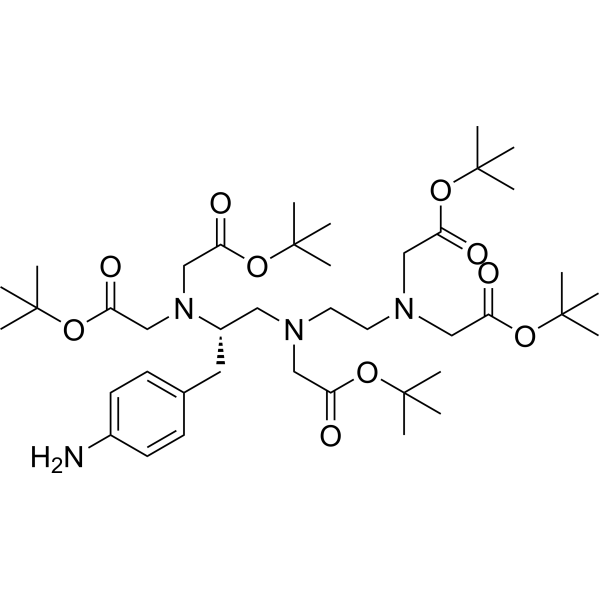
- HY-W250929
-
|
|
Biochemical Assay Reagents
|
Others
|
|
Maleimido-mono-amide-DOTA-tris(t-Bu ester)is a bifunctional chelator (Bifunctional Chelator; BFC) and a macrocyclic DOTA derivative used for tumor pre-targeting. Maleimido-mono-amide-DOTA-tris(t-Bu ester) can be used for conjugation of peptides and radionuclides.
|
-
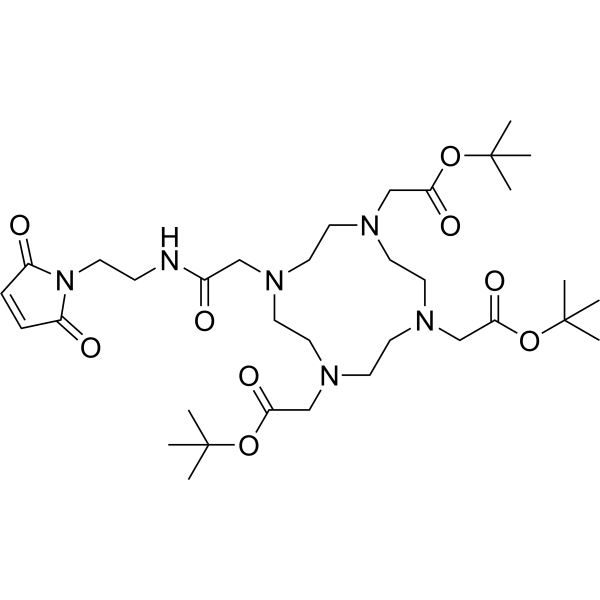
- HY-W460274
-
|
|
Biochemical Assay Reagents
|
Others
|
|
4-Aminobutyl-DOTA-tris(t-butyl ester)is a bifunctional chelator (Bifunctional Chelator; BFC) and a macrocyclic DOTA derivative used for tumor pre-targeting. 4-Aminobutyl-DOTA-tris(t-butyl ester) can be used for conjugation of peptides and radionuclides.
|
-
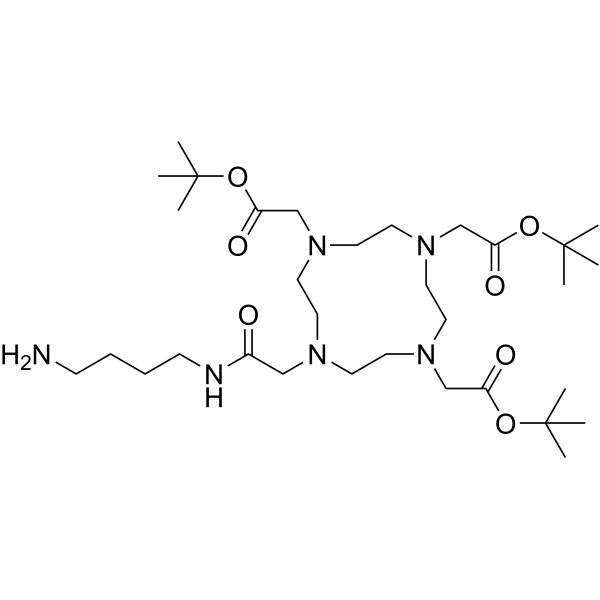
- HY-148646A
-
|
|
Biochemical Assay Reagents
|
Others
|
|
p-NH2-CHX-A"-DTPA (hydrochloride hydrate)is a bifunctional chelator (Bifunctional Chelator; BFC) and a macrocyclic DPTA derivative used for tumor pre-targeting. p-NH2-CHX-A"-DTPA (hydrochloride hydrate) can be used for conjugation of peptides and radionuclides.
|
-

- HY-107486
-
|
Multhiomycin; RP 9671
|
Bacterial
Antibiotic
|
Infection
|
|
Nosiheptide (Multhiomycin), a thiopeptide antibiotic produced by Streptomyces actuosus, inhibits bacterial protein synthesis and bears a unique indole side ring system and regiospecific hydroxyl groups on the characteristic macrocyclic core. Nosiheptide has been widely used as a feed additive for animal growth .
|
-
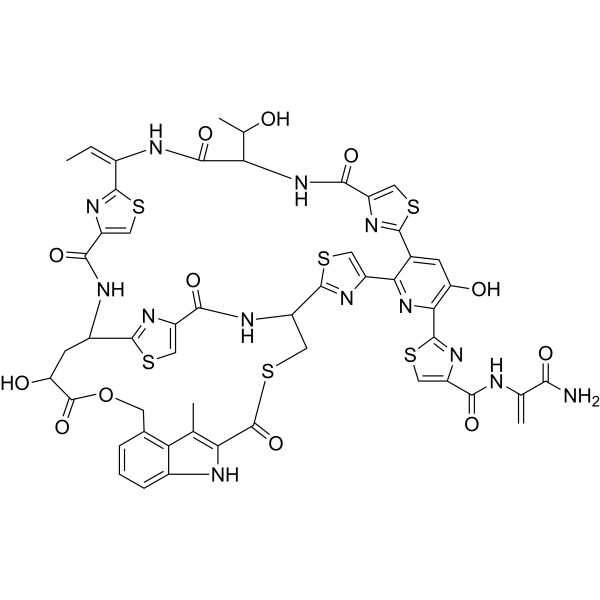
- HY-161096
-
|
|
ROR
|
Cancer
|
|
Antitumor agent-127 (compound 1) is a parent macrocyclic peptide. Antitumor agent-127 displays nanomolar cell-based binding to ROR1 and relatively good internalization in 786-O and MDA-MB-231 tumor cell lines .
|
-
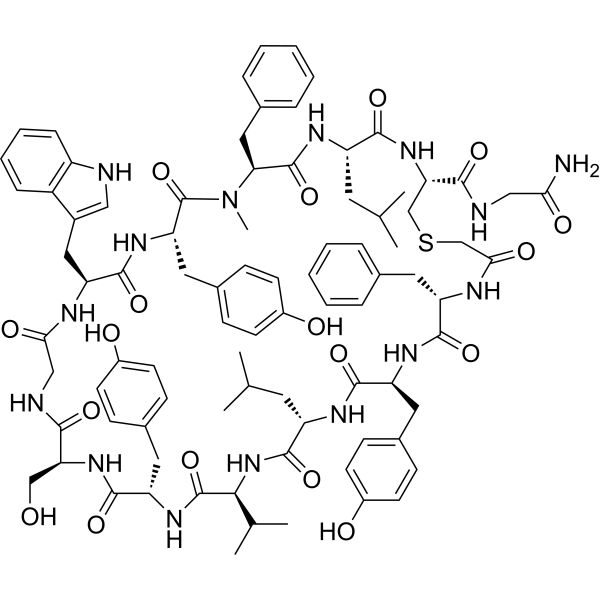
- HY-W749614
-
|
|
Biochemical Assay Reagents
|
Others
|
|
NO2A-Butyne-bis(t-Butyl ester)is a bifunctional chelator (Bifunctional Chelator; BFC) and a macrocyclic NOTA derivative used for tumor pre-targeting. NO2A-Butyne-bis(t-Butyl ester) can be used for conjugation of peptides and radionuclides.
|
-
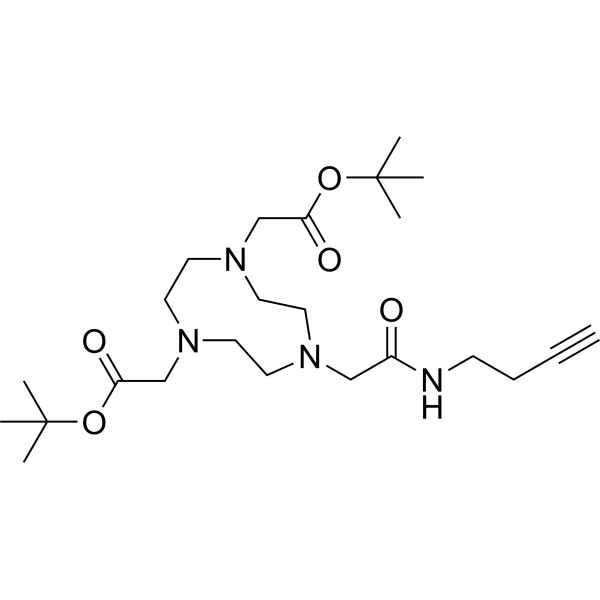
- HY-W749603
-
|
|
Biochemical Assay Reagents
|
Others
|
|
Fmoc-L-Lys-mono-amide-DOTA-tris(t-Bu ester)is a bifunctional chelator (Bifunctional Chelator; BFC) and a macrocyclic DOTA derivative used for tumor pre-targeting. Fmoc-L-Lys-mono-amide-DOTA-tris(t-Bu ester) can be used for conjugation of peptides and radionuclides.
|
-

- HY-W782081
-
|
|
Biochemical Assay Reagents
|
Others
|
|
p-SCN-Bn-oxo-DO3Ais a bifunctional chelator (Bifunctional Chelator; BFC) and a macrocyclic DOTA derivative used for tumor pre-targeting. p-SCN-Bn-oxo-DO3A can be used for conjugation of peptides and radionuclides.
|
-
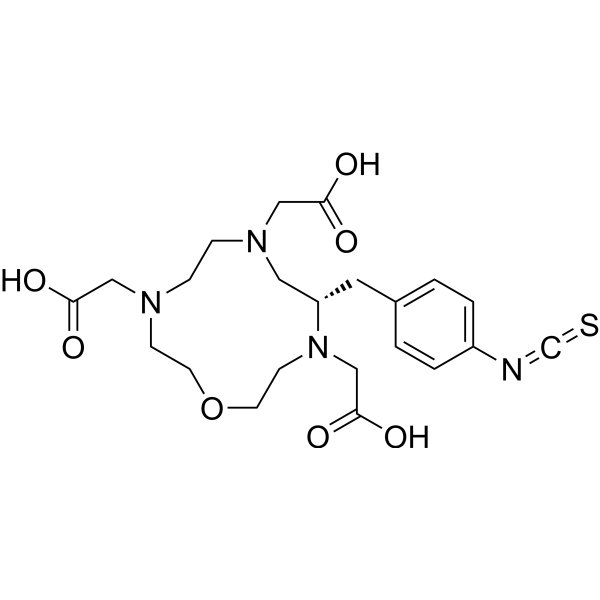
- HY-107212
-
|
|
Parasite
Chloride Channel
P-glycoprotein
Bacterial
|
Infection
|
|
Selamectin, a semi-synthetic macrocyclic lactone, is a potent parasiticide and anthelminthic. Selamectin activates glutamate-gated chloride channels in neurons and pharyngeal muscles to prevent heartworm, Lymphatic filariae, and nematode infection. Selamectin is also a potent P-glycoprotein substrate and a P-glycoprotein inhibitor with an IC50 of 120 nM .
|
-
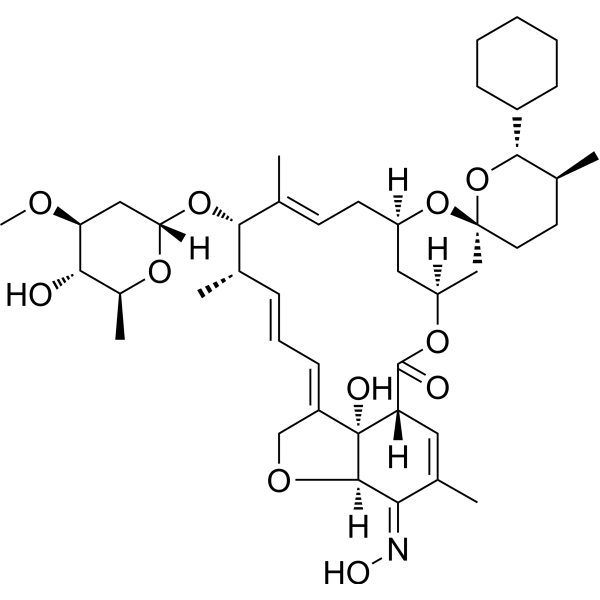
- HY-108602
-
|
|
PKC
|
Cancer
|
|
Bryostatin 3, a macrocyclic lactone, is a protein kinase C activator, with a Ki of 2.75 nM. Bryostatin 3 can block 12-O-tetradecanoylphorbol-13-acetate (TPA) inhibition of cell proliferation, yet did not block TPA-enhanced cell-substratum adhesion .
|
-

- HY-W717760
-
|
|
Biochemical Assay Reagents
|
Others
|
|
p-NH2-Bn-DOTA-tetra(t-Bu ester)is a bifunctional chelator (Bifunctional Chelator; BFC) and a macrocyclic DOTA derivative used for tumor pre-targeting. p-NH2-Bn-DOTA-tetra(t-Bu ester) can be used for conjugation of peptides and radionuclides.
|
-
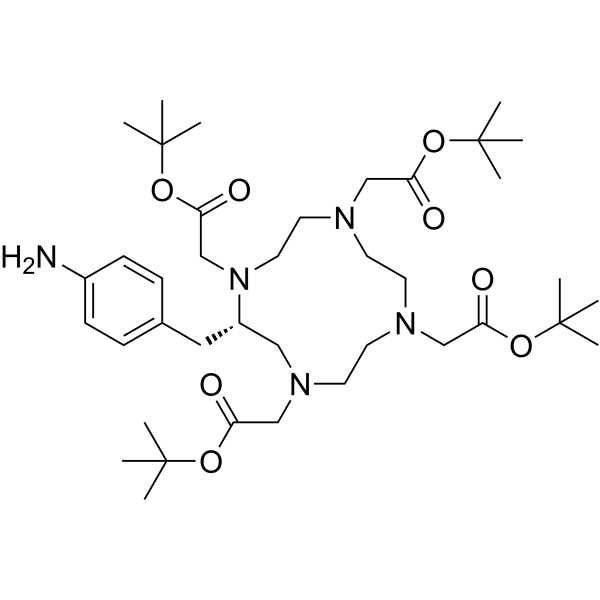
- HY-13557
-
|
Immunomycin; FR-900520; FK520
|
FKBP
Parasite
Fungal
Antibiotic
|
Infection
Neurological Disease
Inflammation/Immunology
|
|
Ascomycin (Immunomycin; FR-900520; FK520) is an ethyl analog of Tacrolimus (FK506) with strong immunosuppressant properties. Ascomycin is also a macrocyclic polyketide antibiotic with multiple biological activities such as anti-malarial, anti-fungal and anti-spasmodic. Ascomycin prevents graft rejection and has potential for varying skin ailments research .
|
-
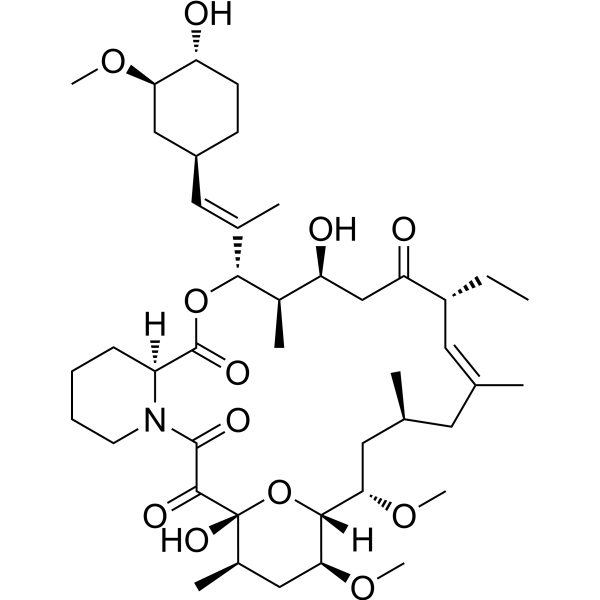
- HY-17580
-
|
OPT-80; PAR-101
|
DNA/RNA Synthesis
Bacterial
Apoptosis
Antibiotic
|
Infection
|
|
Fidaxomicin (OPT-80), a macrocyclic antibiotic, is an orally active and potent RNA polymerase inhibitor. Fidaxomicin has a narrow spectrum of antibacterial activity and a good anti-Clostridium difficile activity (MIC90=0.12 μg/mL). Fidaxomicin can be used for Clostridium difficile infection (CDI) research .
|
-
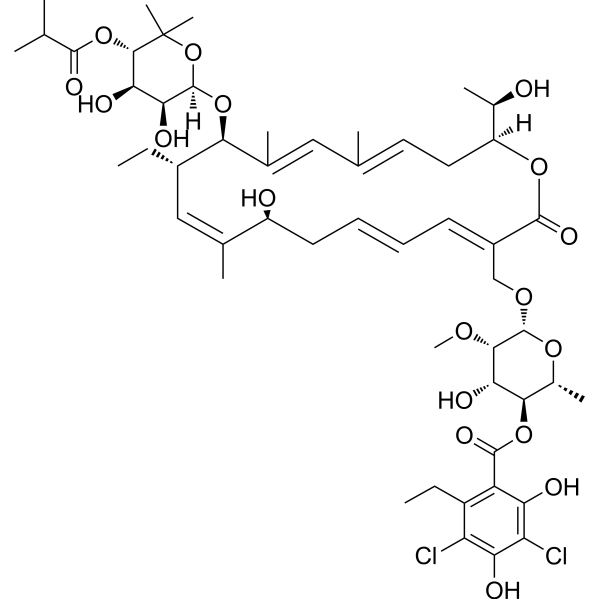
- HY-W782080
-
|
|
Biochemical Assay Reagents
|
Others
|
|
p-NH2-Bn-oxo-DO3Ais a bifunctional chelator (Bifunctional Chelator; BFC) and a macrocyclic DOTA derivative used for tumor pre-targeting. p-NH2-Bn-oxo-DO3A can be used for conjugation of peptides and radionuclides.
|
-
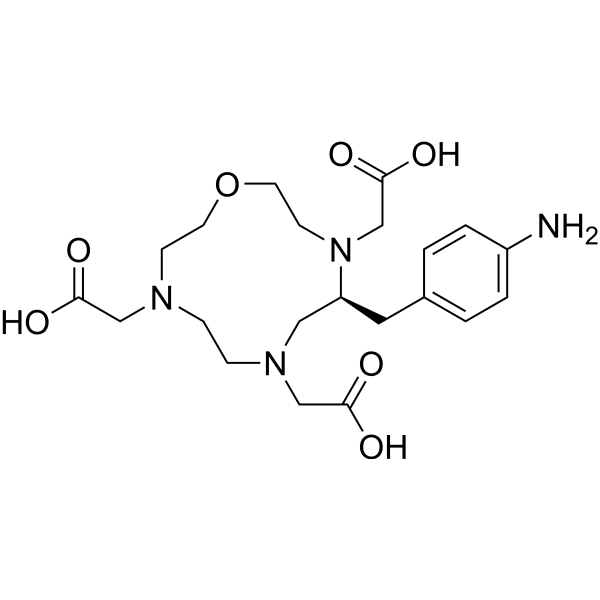
- HY-P10027
-
|
|
Antibiotic
Bacterial
|
Infection
|
|
Clovibactin is an antibiotic for drug-resistant bacterial pathogens without detectable resistance. Clovibactin TFA inihibits cell wall synthesis by targeting pyrophosphate of peptidoglycan precursors .
|
-
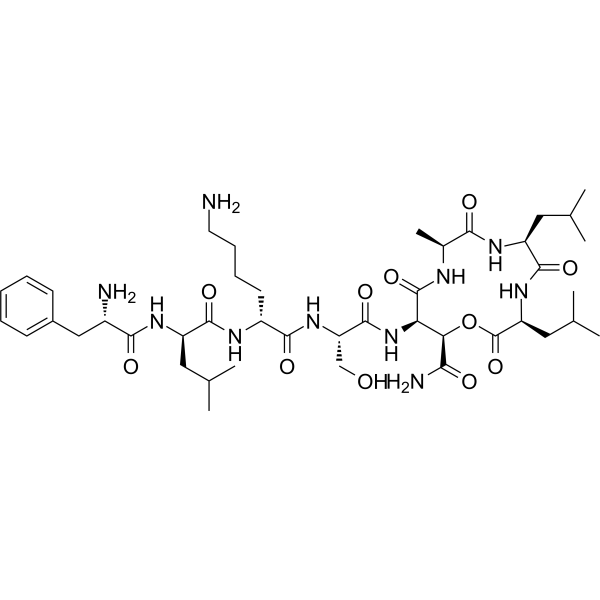
- HY-P10027A
-
|
|
Antibiotic
Bacterial
|
Infection
|
|
Clovibactin TFA is the TFA salt form of Clovibactin (HY-P10027). Clovibactin TFA is an antibiotic for drug-resistant bacterial pathogens without detectable resistance. Clovibactin TFA inihibits cell wall synthesis by targeting pyrophosphate of peptidoglycan precursors .
|
-

- HY-149988
-
|
|
MDM-2/p53
|
Cancer
|
|
UNP-6457 is a potent active MDM2-p53 interaction inhibitor with an IC50 values of 8.9 nM .
|
-
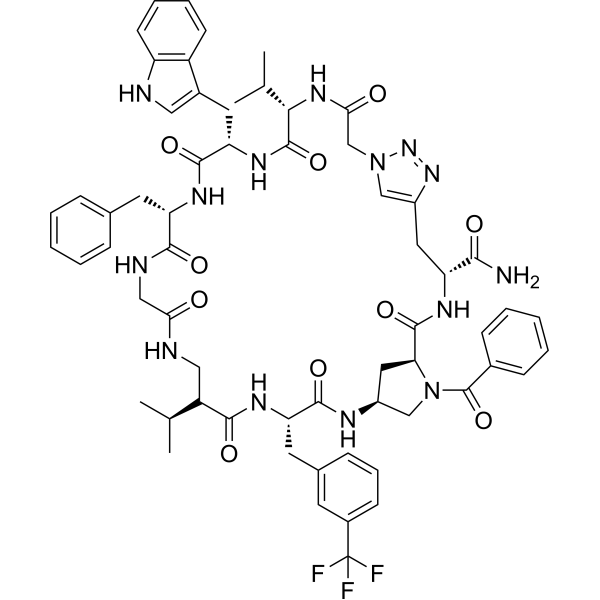
- HY-N0750
-
|
Crotaline
|
Others
|
Metabolic Disease
Cancer
|
Monocrotaline is an 11-membered macrocyclic pyrrolizidine alkaloid. Monocrotaline inhibits OCT-1 and OCT-2 with IC50s of 36.8 µM and 1.8 mM, respectively. Monocrotaline has antitumor activity and is cytotoxic to hepatocellular carcinoma cells. Monocrotaline is used to induce a model of pulmonary hypertension in rodents. [2][6][8].
|
-

- HY-133015
-
|
|
Bcl-2 Family
|
Cancer
|
|
Mcl-1 inhibitor 3 (compound 1) is a highly potent and orally activate macrocyclic Mcl-1 inhibitor (Ki= 0.061 nM; IC50=19 nM in an OPM-2 cell viability assay). Mcl-1 inhibitor 3 shows good pharmacokinetic properties and excellent in vivo efficacy without toxicity ..
|
-

- HY-W034576
-
|
Hexaaza-18-crown-6 hexahydrochloride; 1,4,7,10,13,16-Hexaazacyclooctadecane hexahydrochloride
|
Biochemical Assay Reagents
|
Cancer
|
|
Hexacyclen (Cycloalkene) is an organic compound with a unique macrocyclic structure composed of six nitrogen-containing rings. Hexacyclen is commonly used as a chelating agent in chemistry and biochemistry due to its ability to bind metal ions, and is often used to selectively bind metal ions in proteins or enzymes to study their structure and function. Hexacyclen also acts as an inhibitor of cancer .
|
-
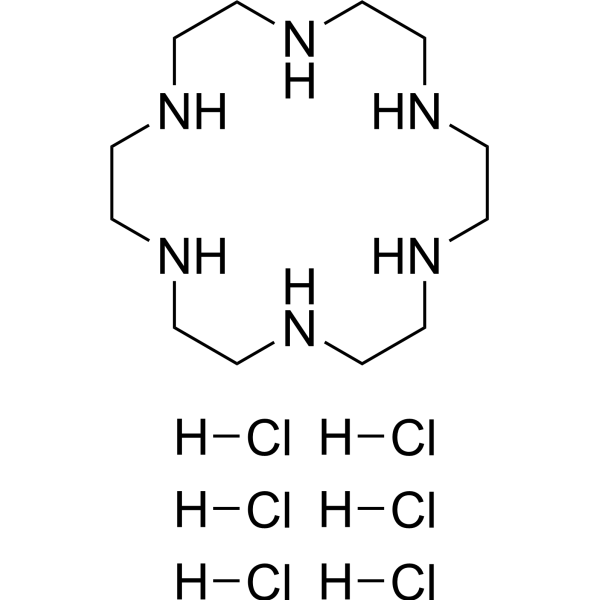
- HY-13756S
-
|
FK506-13C,d2; Fujimycin-13C,d2; FR900506-13C,d2
|
Phosphatase
FKBP
Bacterial
Autophagy
Antibiotic
|
Infection
Inflammation/Immunology
Cancer
|
|
Tacrolimus- 13C,d2 is a 13C-labeled and deuterium labeled Tacrolimus. Tacrolimus (FK506), a macrocyclic lactone, binds to FK506 binding protein (FKBP) to form a complex. Tacrolimus inhibits calcineurin phosphatase, which inhibits T-lymphocyte signal transduction and IL-2 transcription. Immunosuppressive properties[1].
|
-

- HY-W127809
-
|
|
Biochemical Assay Reagents
|
Others
|
|
Chlorin e4 is an organic compound belonging to the family of chlorins, which are macrocyclic compounds with a similar structure to porphyrins. It is commonly used to improve photodynamic therapy for cancer and other diseases. Chlorin e4 has multiple applications in medical research, including as a photosensitizer for localized tumor destruction. In addition, its antimicrobial properties and potential use in disinfection applications were investigated.
|
-

- HY-107212R
-
|
|
Parasite
Chloride Channel
P-glycoprotein
Bacterial
|
Infection
|
|
Selamectin (Standard) is the analytical standard of Selamectin. This product is intended for research and analytical applications. Selamectin, a semi-synthetic macrocyclic lactone, is a potent parasiticide and anthelminthic. Selamectin activates glutamate-gated chloride channels in neurons and pharyngeal muscles to prevent heartworm, Lymphatic filariae, and nematode infection. Selamectin is also a potent P-glycoprotein substrate and a P-glycoprotein inhibitor with an IC50 of 120 nM .
|
-
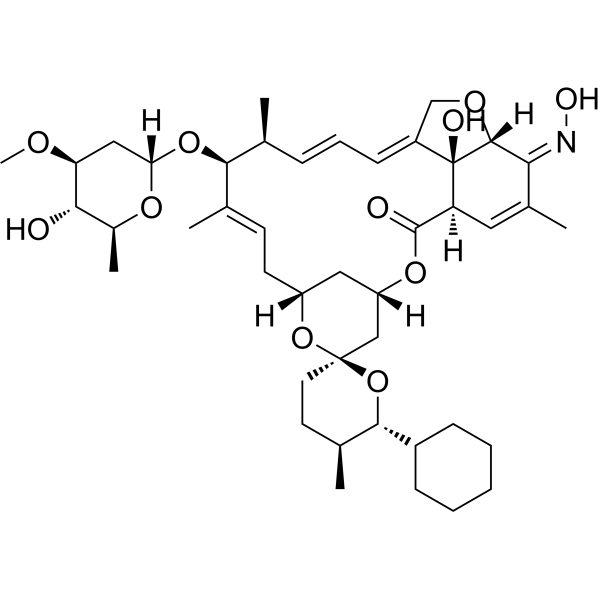
- HY-17580S
-
|
|
Isotope-Labeled Compounds
Bacterial
Apoptosis
Antibiotic
|
Infection
|
|
Fidaxomicin-d7 (OPT-80-D7) is the deuterium labeled Fidaxomicin. Fidaxomicin (OPT-80), a macrocyclic RNA polymerase inhibitor, has a narrow spectrum of activity. Fidaxomicin selectively eradicates pathogenic Clostridium difficile with minimal disruption to the multiple species of bacteria that make up the normal, healthy intestinal flora[1][2].
|
-
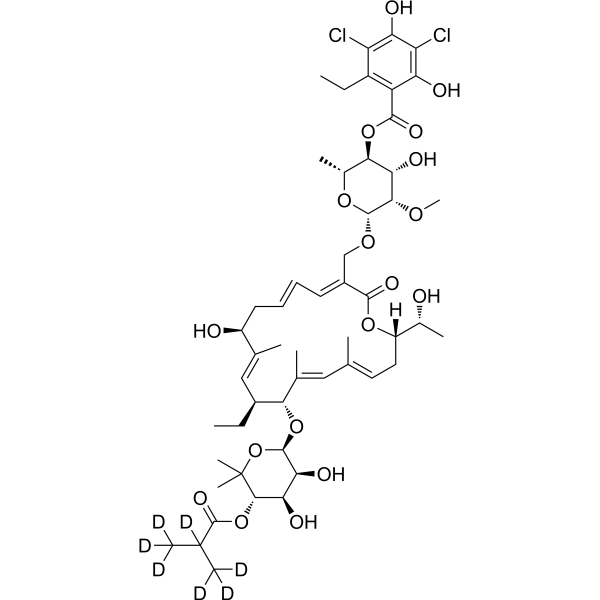
- HY-P1206
-
|
|
Somatostatin Receptor
|
Neurological Disease
|
|
CH 275 is a peptide analog of somatostatin and binds preferably to somatostatin receptor 1 (sst1) with a Ki of 52 nM . CH 275 acts as a potent and selective sst1 agonist (IC50=30.9 nM) and also displays IC50 values of 345 nM, >1 μM, >10 μM, >10 μM for human sst3, sst4, sst2 and sst5, respectively . CH 275 can be used for the research of alzheimer’s disease .
|
-
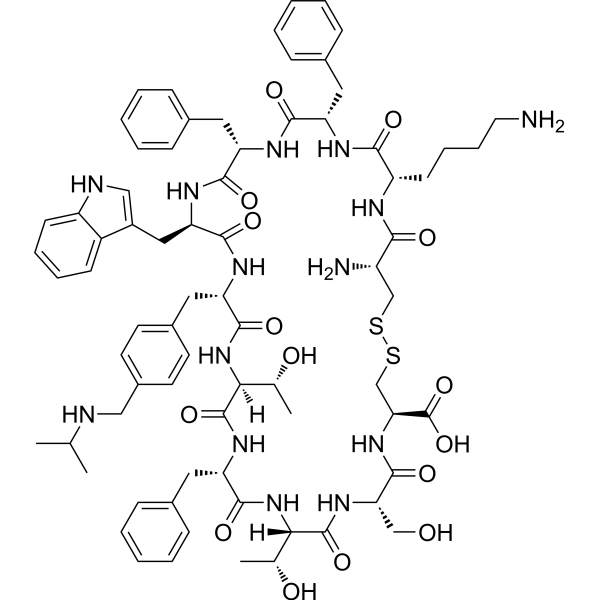
- HY-151905
-
|
|
c-Met/HGFR
|
Cancer
|
|
D6808 is a highly selective and potent c‑Met inhibitor with an IC50 value of 2.9 nM. D6808 induces cell apoptosis and cell cycle arrest. D6808 can be used for the research of NSCLC and gastric cancers .
|
-

- HY-107426
-
|
Muconomycin A
|
Apoptosis
Reactive Oxygen Species
|
Cancer
|
|
Verrucarin A (Muconomycin A), a Type D macrocyclic mycotoxin derived from the pathogen fungus Myrothecium verrucaria, is an inhibitor of protein synthesis. Verrucarin A inhibits growth of leukemia cell lines and activates caspases and apoptosis and inflammatory signaling in macrophages. Verrucarin A effectively increased the phosphorylation of p38 MAPK and diminished the phosphorylation of ERK/Akt. Verrucarin A caused cell cycle deregulation through the induction of p21 and p53 .
|
-

- HY-P3143A
-
|
|
PD-1/PD-L1
|
Cancer
|
|
BMSpep-57 hydrochloride is a potent and competitive macrocyclic peptide inhibitor of PD-1/PD-L1 interaction with an IC50 of 7.68 nM. BMSpep-57 hydrochloride binds to PD-L1 with Kds of 19 nM and 19.88 nM in MST and SPR assays, respectively. BMSpep-57 hydrochloride facilitates T cell function by in creasing IL-2 production in PBMCs .
|
-
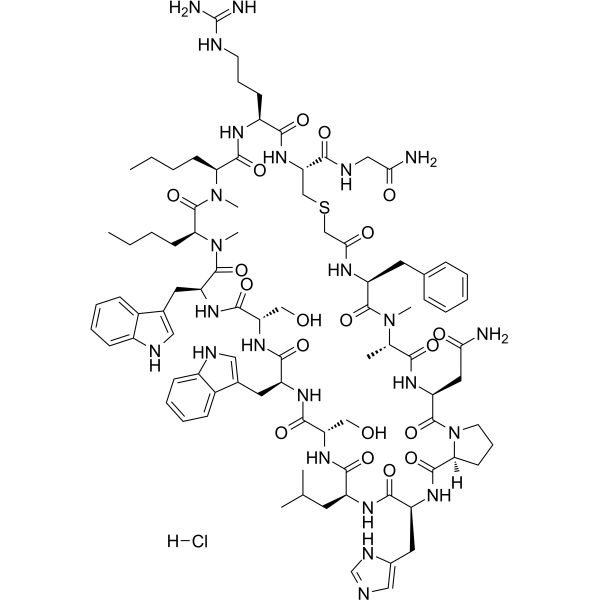
- HY-P3143
-
|
|
PD-1/PD-L1
|
Cancer
|
|
BMSpep-57 is a potent and competitive macrocyclic peptide inhibitor of PD-1/PD-L1 interaction with an IC50 of 7.68 nM. BMSpep-57 binds to PD-L1 with Kds of 19 nM and 19.88 nM in MST and SPR assays, respectively. BMSpep-57 facilitates T cell function by in creasing IL-2 production in PBMCs .
|
-
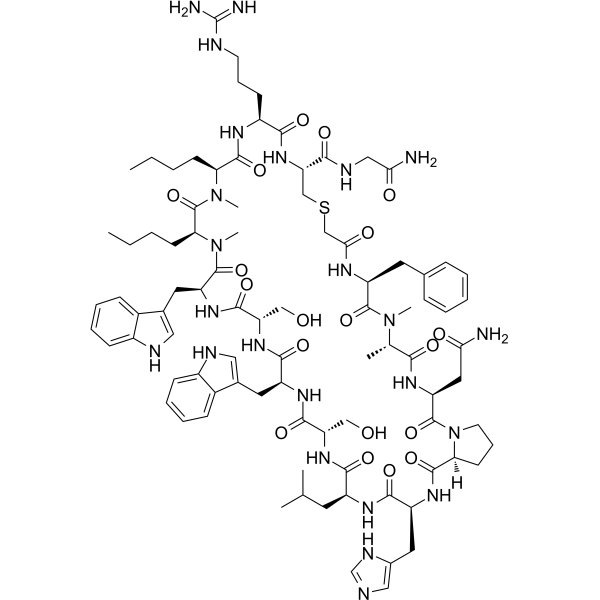
- HY-149034
-
|
S5
|
Influenza Virus
|
Infection
|
|
Influenza A virus-IN-8 (S5) is a macrocyclic peptide with no cytotoxic. Influenza A virus-IN-8 is also a potent Influenza A Virus (IAV) inhibitor (with sufficient protease stability) with IC50s of 6.7 and 6.6 nM for H1 and H5 variants, respectively. Influenza A virus-IN-8 shows good affinitiescan to H1 variants, binds to a conserved region in the HA stem with a Kd of 1.0 nM .
|
-

- HY-144614
-
|
|
DYRK
Apoptosis
|
Neurological Disease
Cancer
|
|
JH-XVII-10 is a potent, selective and orally active DYRK1A and DYRK1B inhibitor with IC50s of 3 nM and 5 nM for DYRK1A and DYRK1B, respectively. JH-XVII-10 shows antitumor efficacy in neck squamous cell carcinoma (HNSCC) cell lines .
|
-
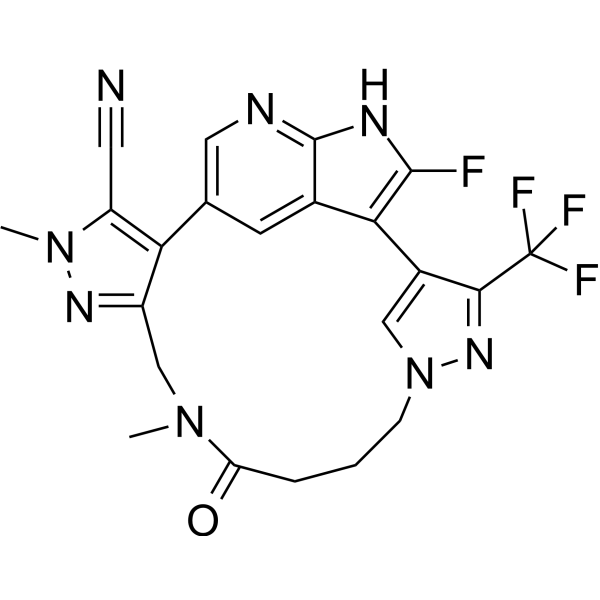
- HY-W034566A
-
|
Hexaaza-18-crown-6 trisulfate; 1,4,7,10,13,16-Hexaazacyclooctadecane trisulfate
|
Biochemical Assay Reagents
|
Others
|
|
Hexacyclen, also known as cycloalkene, is an organic compound with a unique macrocyclic structure composed of six nitrogen-containing rings. It is commonly used as a chelating agent in chemistry and biochemistry due to its ability to bind metal ions. Inhibitors of certain diseases such as cancer. In biochemistry, Hexacyclen is often used to selectively bind metal ions in proteins or enzymes to study their structure and function. Due to its large size and complex structure, Hexacyclen is not widely used in daily products or applications.
|
-
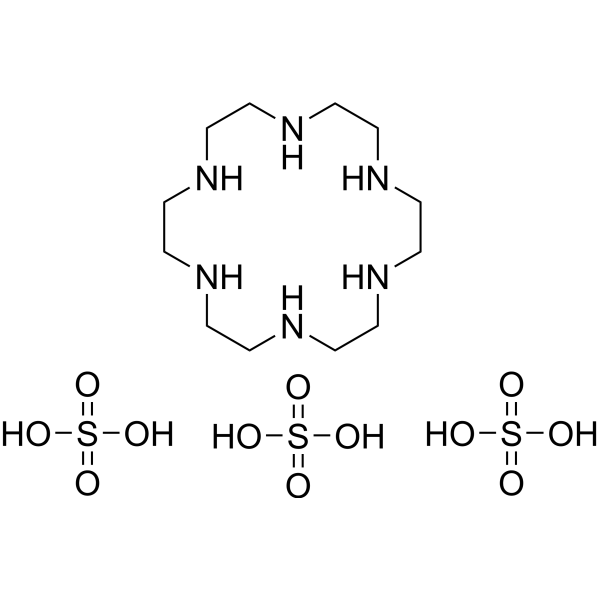
- HY-P3347
-
|
|
Apelin Receptor (APJ)
|
Cardiovascular Disease
|
|
NH2-c[X-R-L-S-X]-K-G-P-(D-2Nal) (compound 40), a macrocyclic analogue of Ape13, is a potent APJ agonist (Ki=5.7 nM). NH2-c[X-R-L-S-X]-K-G-P-(D-2Nal) exhibits a favorable Gα12-biased signaling and an increased in vivo half-life .
|
-
![NH2-c[X-R-L-S-X]-K-G-P-(D-2Nal)](//file.medchemexpress.com/product_pic/hy-p3347.gif)
- HY-125728
-
|
|
Bacterial
Parasite
HCV
|
Infection
|
|
Micrococcin P1 is a macrocyclic peptide antibiotic and is a potent hepatitis C virus (HCV) inhibitor with an EC50 range of 0.1-0.5 μM . Micrococcin P1 has in vitro antibacterial activity against Gram-positive bacterial strains. The MIC values of Micrococcin P1 against S. aureus 1974149, E. faecalis 1674621 and S. pyogenes 1744264 are 2 μg/mL, 1 μg/mL and 1 μg/mL, respectively . Micrococcin P1 is also a potent inhibitor of the malaria parasite Plasmodium falciparum .
|
-

- HY-144739
-
-
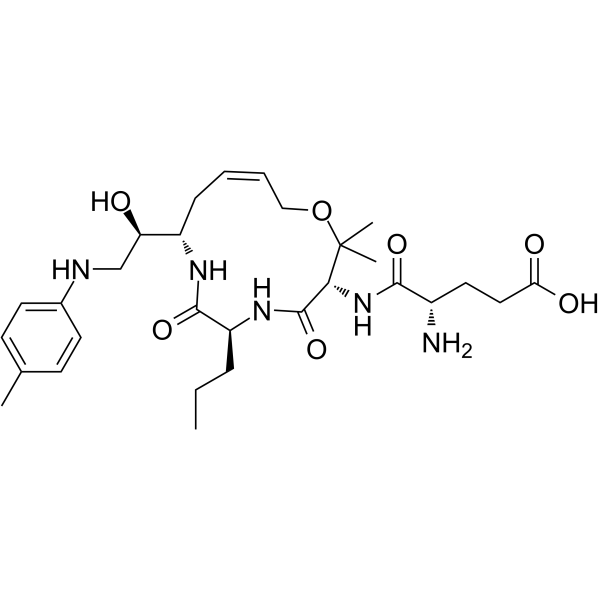
- HY-144741
-
-
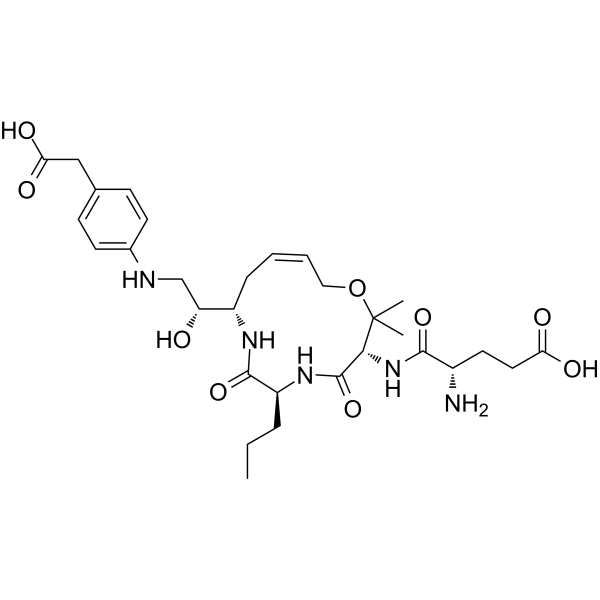
- HY-153221
-
|
|
CDK
|
Cancer
|
|
QR-6401 is an orally active and selective macrocyclic CDK2 inhibitor with IC50 values of 0.37, 10, 22, 34 and 45 nM for CDK2/E1, CDK9/T1, CDK1/A2, CDK6/D3 and CDK4/D1, respectively. QR-6401 has potent antitumor activity in an OVCAR3 ovarian cancer xenograft model. QR-6401 has the potential to be used in the study of cancer .
|
-
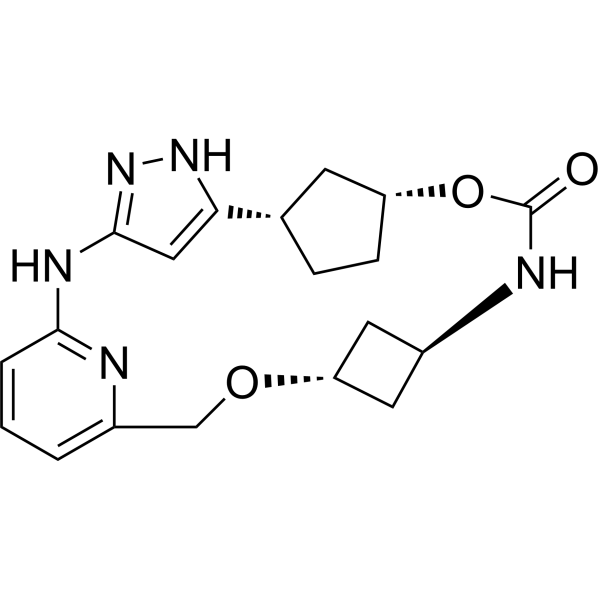
- HY-103048
-
|
|
PD-1/PD-L1
|
Cancer
|
|
PD-1/PD-L1-IN 3, a macrocyclic peptide, is a potent and selective inhibitor of the PD-1/PD-L1 and CD80/PD-L1 interactions extracted from patent WO2014151634A1, compound No.1. PD-1/PD-L1-IN 3 interferes with PD-L1 binding to PD-1 and CD80 by binding to PD-L1, with IC50s of 5.60 nM and 7.04 nM, respectively. PD-1/PD-L1-IN 3 can be used for the research of various diseases, including cancer and infectious diseases .
|
-
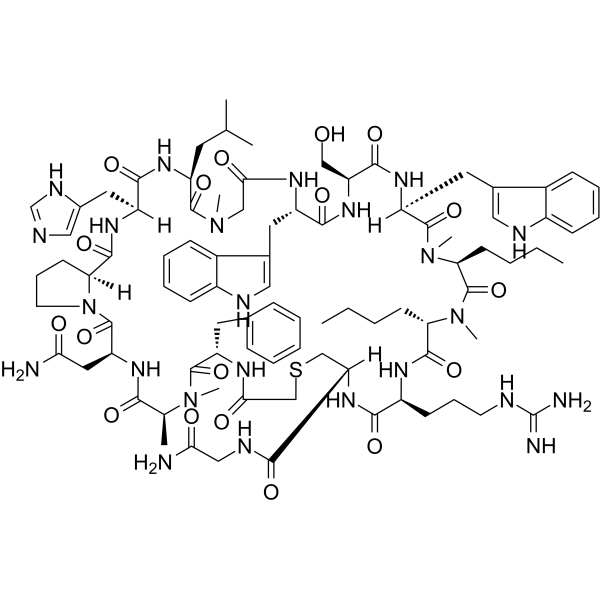
- HY-103048A
-
|
|
PD-1/PD-L1
|
Cancer
|
|
PD-1/PD-L1-IN 3 TFA, a macrocyclic peptide, is a potent and selective inhibitor of the PD-1/PD-L1 and CD80/PD-L1 interactions extracted from patent WO2014151634A1, compound No.1. PD-1/PD-L1-IN 3 TFA interferes with PD-L1 binding to PD-1 and CD80 by binding to PD-L1, with IC50s of 5.60 nM and 7.04 nM, respectively. PD-1/PD-L1-IN 3 TFA can be used for the research of various diseases, including cancer and infectious diseases .
|
-
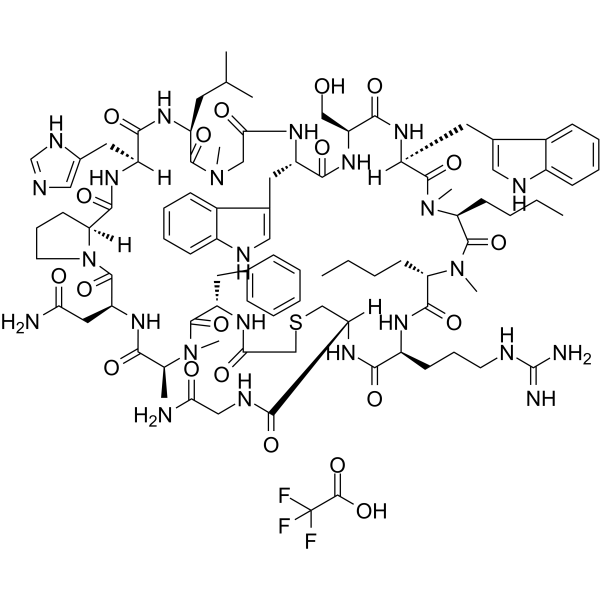
-
-
HY-L041
-
|
|
367 compounds
|
|
Macrocycles, molecules containing 12-membered or larger rings, are receiving increased attention in small-molecule drug discovery. The reasons are several, including providing access to novel chemical space, challenging new protein targets, showing favorable ADME- and PK-properties. Macrocycles have demonstrated repeated success when addressing targets that have proved to be highly challenging for standard small-molecule drug discovery, especially in modulating macromolecular processes such as protein–protein interactions (PPI). Otherwise, the size and complexity of macrocyclic compounds make possible to ensure numerous and spatially distributed binding interactions, thereby increasing both binding affinity and selectivity.
MCE offers a unique collection of 367 macrocyclic compounds which can be used for drug discovery for high throughput screening (HTS) and high content screening (HCS). MCE Macrocyclic Compound Library is a useful tool for discovering new drugs, especially for “undruggable” targets and protein–protein interactions.
|
-
-
HY-L0116V
-
|
|
1,065 compounds
|
|
Macrocycles are promising scaffolds for the design of novel RNA targeting molecules. This collection of macrocycles for RNA consists of very diverse, drug-like molecules which incorporate certain known RNA-recognition elements (e.g. nucleobase ring systems and analogs) distributed within macrocyclic rings or peripheral fragments. As macrocyclic molecules tend to be larger than traditional screening molecules, it is vital to carefully assess and control their physicochemical properties. All macrocycles have been tested for aqueous and DMSO solubility with cutoffs applied at 10 mM in DMSO and 50 µM in PBS (pH 7.4); PAMPA permeability has also been tested for representative set of macrocycles.
|
-
-
HY-L0117V
-
|
|
1,412 compounds
|
|
Glycomimetics are designed to mimic the structure of natural carbohydrates and modulate their disease-related functions. Macrocyclic glycomimetics are an extremely interesting class of glycomimetics as they occupy space between small and macro molecules. Macrocyclic glycomimetics are mostly represented by naturally occurring molecules derived from marine microorganisms and bacterial or fungal metabolites.
|
-
-
HY-L0119V
-
|
|
3,253 compounds
|
|
Protein protein interactions (PPI) have pivotal roles in life processes. The studies showed that aberrant PPI are associated with various diseases. However, the design of modulators targeting PPI still faces tremendous challenges, such the difficult PPI interfaces for the drug design, lack of ligands reference, lack of guidance rules for the PPI modulators development and high-resolution PPI proteins structures.
The PPI Library comprises molecules of various sizes, frameworks, and shapes ranging from fragment-like entities to macrocyclic derivatives designed as secondary structure mimetics or as epitope mimetics. The designs cover β-turn / loop mimetics and α-helix mimetics. Since helices present at the interface in 62% of all protein-protein interactions. This library focused on designs including mimics with the substitution geometry of an a-helices, as well as designs that mimic the location of “hot-spot” side chains in helix-mediated PPIs.
|
-
-
HY-L0115V
-
|
|
10,091 compounds
|
|
ASINEX has elaborated a library of diverse macrocycles using an effective tool box of synthetic methods. The resulting scaffolds are novel, tremendously diverse, medchem-relevant, macrocyclic frameworks.
Macrocyles tend to be larger than traditional screening molecules which make them perfect discovery tools for targets with shallow or extended binding sites. At the same time, their unique character based on restricted flexibility and ability to form intra-molecular hydrogen bonds allows for design approaches effectively optimizing properties such asaqueous solubility and membrane permeability. Many of these macrocycles have been tested for aqueous and DMSO solubility with cut-offs applied at 10 mM in DMSO and 50 µM in PBS (pH 7.4) followed by PAMPA permeability assay.
|
| Cat. No. |
Product Name |
Type |
-
- HY-149620
-
|
|
Dyes
|
|
Cy5-PEG2-exo-BCN is a dye derivative of Cyanine 5 (Cy5) (HY-D0821) containing 2 PEG units. Cy5-PEG2-exo-BCN contains the lyophilic bidentate macrocyclic ligand BCN, which can further synthesize macrocyclic complexes. In click chemistry, BCN reacts with molecules containing azide groups to form stable triazoles in the absence of catalysts.
|
-
- HY-149618
-
|
|
Dyes
|
|
Cy5-PEG3-endo-BCN is a dye derivative of Cyanine 5 (Cy5) (HY-D0821) containing 3 PEG units. Cy5-PEG3-endo-BCN contains the lyophilic bidentate macrocyclic ligand endo-BCN, which can further synthesize macrocyclic complexes. In click chemistry, endo-BCN can react with molecules containing azide groups to form stable triazoles in the absence of catalysts.
|
-
- HY-149619
-
|
|
Dyes
|
|
Cy5-PEG7-endo-BCN is a dye derivative of Cyanine 5 (Cy5) (HY-D0821) containing 7 PEG units. Cy5-PEG7-endo-BCN contains the lyophilic bidentate macrocyclic ligand endo-BCN, which can further synthesize macrocyclic complexes. In click chemistry, endo-BCN can react with molecules containing azide groups to form stable triazoles in the absence of catalysts.
|
-
- HY-155327
-
|
|
Fluorescent Dyes/Probes
|
|
Cy3-PEG2-endo-BCN is a dye derivative of Cyanine 3 (Cy3) (HY-D0822) containing 2 PEG units. Cy3-PEG2-endo-BCN contains the lyophilic bidentate macrocyclic ligand endo-BCN, which can further synthesize macrocyclic complexes. In click chemistry, endo-BCN can react with molecules containing azide groups to form stable triazoles in the absence of catalysts.
|
| Cat. No. |
Product Name |
Type |
-
- HY-W088413
-
|
|
Chelators
|
|
DOTA-amideis a bifunctional chelator (Bifunctional Chelator; BFC) and a macrocyclic DOTA derivative used for tumor pre-targeting. DOTA-amide can be used for conjugation of peptides and radionuclides.
|
-
- HY-138134
-
|
|
Chelators
|
|
NOTPis a bifunctional chelator (Bifunctional Chelator; BFC) and a macrocyclic NOTA derivative used for tumor pre-targeting. NOTP can be used for conjugation of peptides and radionuclides.
|
-
- HY-134418A
-
|
|
Chelators
|
|
NOTA (trihydrochloride)is a bifunctional chelator (Bifunctional Chelator; BFC) and a macrocyclic NOTA derivative used for tumor pre-targeting. NOTA (trihydrochloride) can be used for conjugation of peptides and radionuclides.
|
-
- HY-138269A
-
|
CHX-A''-DTPA-NCS hydrochloride
|
Chelators
|
|
Barzuxetan (hydrochloride)is a bifunctional chelator (Bifunctional Chelator; BFC) and a macrocyclic DPTA derivative used for tumor pre-targeting. Barzuxetan (hydrochloride) can be used for conjugation of peptides and radionuclides.
|
-
- HY-158067
-
|
DFO-DBCO
|
Chelators
|
|
Deferoxamine-DBCOis a bifunctional chelator (Bifunctional Chelator; BFC) and a macrocyclic DFO derivative used for tumor pre-targeting. Deferoxamine-DBCO can be used for conjugation of peptides and radionuclides.
|
-
- HY-W782078
-
|
|
Chelators
|
|
Butyne-DOTAis a bifunctional chelator (Bifunctional Chelator; BFC) and a macrocyclic DOTA derivative used for tumor pre-targeting. Butyne-DOTA can be used for conjugation of peptides and radionuclides.
|
-
- HY-W678394
-
|
|
Chelators
|
|
DOTA-Thiolis a bifunctional chelator (Bifunctional Chelator; BFC) and a macrocyclic DOTA derivative used for tumor pre-targeting. DOTA-Thiol can be used for conjugation of peptides and radionuclides.
|
-
- HY-158072
-
|
|
Chelators
|
|
DOTAM-NHS-esteris a bifunctional chelator (Bifunctional Chelator; BFC) and a macrocyclic DOTA derivative used for tumor pre-targeting. DOTAM-NHS-ester can be used for conjugation of peptides and radionuclides.
|
-
- HY-W717830
-
|
|
Chelators
|
|
CB-Cyclamis a bifunctional chelator (Bifunctional Chelator; BFC), which is a main chain Cyclen derivative of the macrocyclic ligand tetradecane. CB-Cyclam can be used for conjugation of peptides and radionuclides.
|
-
- HY-W717743
-
|
|
Chelators
|
|
DOTAM-mono-acidis a bifunctional chelator (Bifunctional Chelator; BFC) and a macrocyclic DOTA derivative used for tumor pre-targeting. DOTAM-mono-acid can be used for conjugation of peptides and radionuclides.
|
-
- HY-W726767
-
|
|
Chelators
|
|
DO2Ais a bifunctional chelator (Bifunctional Chelator; BFC) and a macrocyclic DOTA derivative used for tumor pre-targeting. DO2A can be used for conjugation of peptides and radionuclides.
|
-
- HY-W717782
-
|
|
Chelators
|
|
Bz-DTPA (hydrochloride)is a bifunctional chelator (Bifunctional Chelator; BFC) and a macrocyclic DPTA derivative used for tumor pre-targeting. Bz-DTPA (hydrochloride) can be used for conjugation of peptides and radionuclides.
|
-
- HY-W087027A
-
|
|
Chelators
|
|
Maleimide-NOTA (TFA)is a bifunctional chelator (Bifunctional Chelator; BFC) and a macrocyclic NOTA derivative used for tumor pre-targeting. Maleimide-NOTA (TFA) can be used for conjugation of peptides and radionuclides.
|
-
- HY-158077
-
|
(R)-tetraMe-DOTA
|
Chelators
|
|
(R)-tetraMe-Tetraxetanis a bifunctional chelator (Bifunctional Chelator; BFC) and a macrocyclic DOTA derivative used for tumor pre-targeting. (R)-tetraMe-Tetraxetan can be used for conjugation of peptides and radionuclides.
|
-
- HY-W250844A
-
|
|
Chelators
|
|
DO3A (trisodium)is a bifunctional chelator (Bifunctional Chelator; BFC) and a macrocyclic DOTA derivative used for tumor pre-targeting. DO3A (trisodium) can be used for conjugation of peptides and radionuclides.
|
-
- HY-W539916
-
|
|
Chelators
|
|
Azido-mono-amide-DOTAis a bifunctional chelator (Bifunctional Chelator; BFC) and a macrocyclic DOTA derivative used for tumor pre-targeting. Azido-mono-amide-DOTA can be used for conjugation of peptides and radionuclides.
|
-
- HY-158071
-
|
|
Chelators
|
|
p-SCN-Bn-HEHA (hydrochloride)is a bifunctional chelator (Bifunctional Chelator; BFC) and a macrocyclic DPTA derivative used for tumor pre-targeting. p-SCN-Bn-HEHA (hydrochloride) can be used for drug conjugation.
|
-
- HY-128890A
-
|
|
Chelators
|
|
DOTA-NHS-ester (hexafluorophosphate TFA)is a bifunctional chelator (Bifunctional Chelator; BFC) and a macrocyclic DOTA derivative used for tumor pre-targeting. DOTA-NHS-ester (hexafluorophosphate TFA) can be used for conjugation of peptides and radionuclides.
|
-
- HY-W717779
-
|
|
Chelators
|
|
4-Aminobutyl-DOTAis a bifunctional chelator (Bifunctional Chelator; BFC) and a macrocyclic DOTA derivative used for tumor pre-targeting. 4-Aminobutyl-DOTA can be used for conjugation of peptides and radionuclides.
|
-
- HY-A0074
-
|
tetra-tBu-DTPA
|
Chelators
|
|
DTPA-tetra (t-Bu ester)is a bifunctional chelator (Bifunctional Chelator; BFC) and a macrocyclic DPTA derivative used for tumor pre-targeting. DTPA-tetra (t-Bu ester) can be used for conjugation of peptides and radionuclides.
|
-
- HY-W717781A
-
|
|
Chelators
|
|
p-NH?-Bn-DTPA (hydrochloride)is a bifunctional chelator (Bifunctional Chelator; BFC) and a macrocyclic DPTA derivative used for tumor pre-targeting. p-NH?-Bn-DTPA (hydrochloride) can be used for conjugation of peptides and radionuclides.
|
-
- HY-W782088A
-
|
|
Chelators
|
|
p-NH?-Bn-PCTA (hydrochloride)is a bifunctional chelator (Bifunctional Chelator; BFC) and a macrocyclic DPTA derivative used for tumor pre-targeting. p-NH?-Bn-PCTA (hydrochloride) can be used for conjugation of peptides and radionuclides.
|
-
- HY-W782087A
-
|
|
Chelators
|
|
p-SCN-Bn-PCTA (hydrochloride)is a bifunctional chelator (Bifunctional Chelator; BFC) and a macrocyclic DPTA derivative used for tumor pre-targeting. p-SCN-Bn-PCTA (hydrochloride) can be used for conjugation of peptides and radionuclides.
|
-
- HY-W782083
-
|
|
Chelators
|
|
p-SCN-Bn-NOTA (trihydrochloride)is a bifunctional chelator (Bifunctional Chelator; BFC) and a macrocyclic NOTA derivative used for tumor pre-targeting. p-SCN-Bn-NOTA (trihydrochloride) can be used for conjugation of peptides and radionuclides.
|
-
- HY-156038
-
|
|
Chelators
|
|
(S)-p-SCN-Bn-DOTAis a bifunctional chelator (Bifunctional Chelator; BFC) and a macrocyclic DOTA derivative used for tumor pre-targeting. (S)-p-SCN-Bn-DOTA can be used for conjugation of peptides and radionuclides.
|
-
- HY-W749627
-
|
|
Chelators
|
|
NO2A-Butyneis a bifunctional chelator (Bifunctional Chelator; BFC) and a macrocyclic NOTA derivative used for tumor pre-targeting. NO2A-Butyne can be used for conjugation of peptides and radionuclides.
|
-
- HY-158068
-
|
|
Chelators
|
|
Maleimido-mono-amide-DTPA (TFA)is a bifunctional chelator (Bifunctional Chelator; BFC) and a macrocyclic DPTA derivative used for tumor pre-targeting. Maleimido-mono-amide-DTPA (TFA) can be used for conjugation of peptides and radionuclides.
|
-
- HY-W802013
-
|
|
Chelators
|
|
DOTA-4AMPis a bifunctional chelator (Bifunctional Chelator; BFC) and a macrocyclic DOTA derivative used for tumor pre-targeting. DOTA-4AMP can be used for conjugation of peptides and radionuclides.
|
-
- HY-131673A
-
|
|
Chelators
|
|
(S)-p-SCN-Bn-TCMC (hydrochloride)is a bifunctional chelator (Bifunctional Chelator; BFC) and a macrocyclic DOTA derivative used for tumor pre-targeting. (S)-p-SCN-Bn-TCMC (hydrochloride) can be used for conjugation of peptides and radionuclides.
|
-
- HY-W451440
-
|
|
Chelators
|
|
Butyne-DOTA-tris(t-butyl ester)is a bifunctional chelator (Bifunctional Chelator; BFC) and a macrocyclic DOTA derivative used for tumor pre-targeting. Butyne-DOTA-tris(t-butyl ester) can be used for conjugation of peptides and radionuclides.
|
-
- HY-W717800A
-
|
|
Chelators
|
|
NO2A-Azide (trihydrochloride)is a bifunctional chelator (Bifunctional Chelator; BFC) and a macrocyclic NOTA derivative used for tumor pre-targeting. NO2A-Azide (trihydrochloride) can be used for conjugation of peptides and radionuclides.
|
-
- HY-156138A
-
|
|
Chelators
|
|
CB-TE2A (tetrahydrochloride)is a bifunctional chelator (Bifunctional Chelator; BFC), which is a TETA derivative of the macrocyclic ligand tetradecane backbone. CB-TE2A (tetrahydrochloride) can be used for conjugation of peptides and radionuclides.
|
-
- HY-W717833
-
|
|
Chelators
|
|
NO2A-(t-Bu ester)is a bifunctional chelator (Bifunctional Chelator; BFC) and a macrocyclic NOTA derivative used for tumor pre-targeting. NO2A-(t-Bu ester) can be used for conjugation of peptides and radionuclides.
|
-
- HY-W717742
-
|
|
Chelators
|
|
p-NO2-Bn-Cyclenis a bifunctional chelator (Bifunctional Chelator; BFC), which is a derivative of the macrocyclic ligand dodecane backbone Cyclen. p-NO2-Bn-Cyclen can be used for conjugation of peptides and radionuclides.
|
-
- HY-48876
-
|
|
Chelators
|
|
p-NH2-Bn-DOTAis a bifunctional chelator (Bifunctional Chelator; BFC) and a macrocyclic DOTA derivative used for tumor pre-targeting. p-NH2-Bn-DOTA can be used for conjugation of peptides and radionuclides.
|
-
- HY-W782075
-
|
|
Chelators
|
|
p-NO2-Bn-DOTAis a bifunctional chelator (Bifunctional Chelator; BFC) and a macrocyclic DOTA derivative used for tumor pre-targeting. p-NO2-Bn-DOTA can be used for conjugation of peptides and radionuclides.
|
-
- HY-158066
-
|
|
Chelators
|
|
p-NH2-Bn-NOTA (hydrochloride hydrate)is a bifunctional chelator (Bifunctional Chelator; BFC) and a macrocyclic NOTA derivative used for tumor pre-targeting. p-NH2-Bn-NOTA (hydrochloride hydrate) can be used for conjugation of peptides and radionuclides.
|
-
- HY-158069
-
|
|
Chelators
|
|
p-NH?-Bn-DTPA-penta (t-Bu ester)is a bifunctional chelator (Bifunctional Chelator; BFC) and a macrocyclic DPTA derivative used for tumor pre-targeting. p-NH?-Bn-DTPA-penta (t-Bu ester) can be used for conjugation of peptides and radionuclides.
|
-
- HY-W250929
-
|
|
Chelators
|
|
Maleimido-mono-amide-DOTA-tris(t-Bu ester)is a bifunctional chelator (Bifunctional Chelator; BFC) and a macrocyclic DOTA derivative used for tumor pre-targeting. Maleimido-mono-amide-DOTA-tris(t-Bu ester) can be used for conjugation of peptides and radionuclides.
|
-
- HY-W460274
-
|
|
Chelators
|
|
4-Aminobutyl-DOTA-tris(t-butyl ester)is a bifunctional chelator (Bifunctional Chelator; BFC) and a macrocyclic DOTA derivative used for tumor pre-targeting. 4-Aminobutyl-DOTA-tris(t-butyl ester) can be used for conjugation of peptides and radionuclides.
|
-
- HY-148646A
-
|
|
Chelators
|
|
p-NH2-CHX-A"-DTPA (hydrochloride hydrate)is a bifunctional chelator (Bifunctional Chelator; BFC) and a macrocyclic DPTA derivative used for tumor pre-targeting. p-NH2-CHX-A"-DTPA (hydrochloride hydrate) can be used for conjugation of peptides and radionuclides.
|
-
- HY-W749614
-
|
|
Chelators
|
|
NO2A-Butyne-bis(t-Butyl ester)is a bifunctional chelator (Bifunctional Chelator; BFC) and a macrocyclic NOTA derivative used for tumor pre-targeting. NO2A-Butyne-bis(t-Butyl ester) can be used for conjugation of peptides and radionuclides.
|
-
- HY-W749603
-
|
|
Chelators
|
|
Fmoc-L-Lys-mono-amide-DOTA-tris(t-Bu ester)is a bifunctional chelator (Bifunctional Chelator; BFC) and a macrocyclic DOTA derivative used for tumor pre-targeting. Fmoc-L-Lys-mono-amide-DOTA-tris(t-Bu ester) can be used for conjugation of peptides and radionuclides.
|
-
- HY-W782081
-
|
|
Chelators
|
|
p-SCN-Bn-oxo-DO3Ais a bifunctional chelator (Bifunctional Chelator; BFC) and a macrocyclic DOTA derivative used for tumor pre-targeting. p-SCN-Bn-oxo-DO3A can be used for conjugation of peptides and radionuclides.
|
-
- HY-W717760
-
|
|
Chelators
|
|
p-NH2-Bn-DOTA-tetra(t-Bu ester)is a bifunctional chelator (Bifunctional Chelator; BFC) and a macrocyclic DOTA derivative used for tumor pre-targeting. p-NH2-Bn-DOTA-tetra(t-Bu ester) can be used for conjugation of peptides and radionuclides.
|
-
- HY-W782080
-
|
|
Chelators
|
|
p-NH2-Bn-oxo-DO3Ais a bifunctional chelator (Bifunctional Chelator; BFC) and a macrocyclic DOTA derivative used for tumor pre-targeting. p-NH2-Bn-oxo-DO3A can be used for conjugation of peptides and radionuclides.
|
-
- HY-W034576
-
|
Hexaaza-18-crown-6 hexahydrochloride; 1,4,7,10,13,16-Hexaazacyclooctadecane hexahydrochloride
|
Biochemical Assay Reagents
|
|
Hexacyclen (Cycloalkene) is an organic compound with a unique macrocyclic structure composed of six nitrogen-containing rings. Hexacyclen is commonly used as a chelating agent in chemistry and biochemistry due to its ability to bind metal ions, and is often used to selectively bind metal ions in proteins or enzymes to study their structure and function. Hexacyclen also acts as an inhibitor of cancer .
|
-
- HY-W127809
-
|
|
Biochemical Assay Reagents
|
|
Chlorin e4 is an organic compound belonging to the family of chlorins, which are macrocyclic compounds with a similar structure to porphyrins. It is commonly used to improve photodynamic therapy for cancer and other diseases. Chlorin e4 has multiple applications in medical research, including as a photosensitizer for localized tumor destruction. In addition, its antimicrobial properties and potential use in disinfection applications were investigated.
|
-
- HY-W034566A
-
|
Hexaaza-18-crown-6 trisulfate; 1,4,7,10,13,16-Hexaazacyclooctadecane trisulfate
|
Biochemical Assay Reagents
|
|
Hexacyclen, also known as cycloalkene, is an organic compound with a unique macrocyclic structure composed of six nitrogen-containing rings. It is commonly used as a chelating agent in chemistry and biochemistry due to its ability to bind metal ions. Inhibitors of certain diseases such as cancer. In biochemistry, Hexacyclen is often used to selectively bind metal ions in proteins or enzymes to study their structure and function. Due to its large size and complex structure, Hexacyclen is not widely used in daily products or applications.
|
| Cat. No. |
Product Name |
Target |
Research Area |
-
- HY-P5963
-
-
- HY-P3502
-
|
RA101495; RA3193
|
Complement System
|
Inflammation/Immunology
|
|
Zilucoplan (RA101495), a 15-amino acid macrocyclic peptide, is a potent complement component 5 (C5) inhibitor. Zilucoplan can be used in research of immune-mediated necrotising myopathy (IMNM) .
|
-
- HY-158150
-
|
|
Proteasome
|
Cancer
|
|
20S Proteasome-IN-5 (Compound 5) is a macrocyclic inhibitor of the 20S Proteasome, with IC50 values of 0.19 and 52.5 μM for ChT-L and PGPH-L activity, respectively .
|
-
- HY-P3193A
-
|
|
Peptides
|
Others
|
|
Cyclic nona-L-arginine hydrochloride, a nonaarginine peptide used for drug delivery, translocates faster than their linear counterparts .
|
-
- HY-P3193
-
|
|
Peptides
|
Others
|
|
Cyclic nona-L-arginine TFA, a nonaarginine peptide used for drug delivery, translocates faster than their linear counterparts .
|
-
- HY-P4102
-
|
|
Peptides
|
Cancer
|
|
Cyclic PSAP peptide is a cyclic pentapeptide (DWLPK). Cyclic PSAP peptide exhibits agent-like properties and could inhibit metastatic spread and restrain tumor development in general in vivo .
|
-
- HY-N10585
-
|
|
Antibiotic
Bacterial
|
Infection
|
|
Malacidin B is a macrocyclic lipopeptide antibiotic that shows antibacterial activity in a calcium-dependent manner .
|
-
- HY-P3270
-
|
|
Bacterial
Antibiotic
|
Infection
|
|
Capreomycin is a macrocyclic peptide antibiotic. Capreomycin can be used for anti-multidrug-resistant-tuberculosis research. Capreomycin can inhibit phenylalanine synthesis in in mycobacterial ribosomes translation
|
-
- HY-P3502A
-
|
RA101495 TFA; RA3193 TFA
|
Complement System
|
Inflammation/Immunology
|
|
Zilucoplan TFA (RA101495), a 15-amino acid macrocyclic peptide, is a potent complement component 5 (C5) inhibitor. Zilucoplan TFA can be used in research of immune-mediated necrotising myopathy (IMNM) .
|
-
- HY-P5753A
-
|
|
Bacterial
|
Infection
|
|
JB-95 acetate, a β-hairpin macrocyclic peptide, exhibits potent antimicrobial activity against Escherichia coli. JB-95 acetate can selectively disrupt the outer membrane but not the inner membrane of E. coli .
|
-
- HY-P5753
-
|
|
Bacterial
|
Infection
|
|
JB-95, a β-hairpin macrocyclic peptide, exhibits potent antimicrobial activity against Escherichia coli. JB-95 can selectively disrupt the outer membrane but not the inner membrane of E. coli .
|
-
- HY-P10027
-
|
|
Antibiotic
Bacterial
|
Infection
|
|
Clovibactin is an antibiotic for drug-resistant bacterial pathogens without detectable resistance. Clovibactin TFA inihibits cell wall synthesis by targeting pyrophosphate of peptidoglycan precursors .
|
-
- HY-P10027A
-
|
|
Antibiotic
Bacterial
|
Infection
|
|
Clovibactin TFA is the TFA salt form of Clovibactin (HY-P10027). Clovibactin TFA is an antibiotic for drug-resistant bacterial pathogens without detectable resistance. Clovibactin TFA inihibits cell wall synthesis by targeting pyrophosphate of peptidoglycan precursors .
|
-
- HY-P1206
-
|
|
Somatostatin Receptor
|
Neurological Disease
|
|
CH 275 is a peptide analog of somatostatin and binds preferably to somatostatin receptor 1 (sst1) with a Ki of 52 nM . CH 275 acts as a potent and selective sst1 agonist (IC50=30.9 nM) and also displays IC50 values of 345 nM, >1 μM, >10 μM, >10 μM for human sst3, sst4, sst2 and sst5, respectively . CH 275 can be used for the research of alzheimer’s disease .
|
-
- HY-P3143A
-
|
|
PD-1/PD-L1
|
Cancer
|
|
BMSpep-57 hydrochloride is a potent and competitive macrocyclic peptide inhibitor of PD-1/PD-L1 interaction with an IC50 of 7.68 nM. BMSpep-57 hydrochloride binds to PD-L1 with Kds of 19 nM and 19.88 nM in MST and SPR assays, respectively. BMSpep-57 hydrochloride facilitates T cell function by in creasing IL-2 production in PBMCs .
|
-
- HY-P3143
-
|
|
PD-1/PD-L1
|
Cancer
|
|
BMSpep-57 is a potent and competitive macrocyclic peptide inhibitor of PD-1/PD-L1 interaction with an IC50 of 7.68 nM. BMSpep-57 binds to PD-L1 with Kds of 19 nM and 19.88 nM in MST and SPR assays, respectively. BMSpep-57 facilitates T cell function by in creasing IL-2 production in PBMCs .
|
-
- HY-149034
-
|
S5
|
Influenza Virus
|
Infection
|
|
Influenza A virus-IN-8 (S5) is a macrocyclic peptide with no cytotoxic. Influenza A virus-IN-8 is also a potent Influenza A Virus (IAV) inhibitor (with sufficient protease stability) with IC50s of 6.7 and 6.6 nM for H1 and H5 variants, respectively. Influenza A virus-IN-8 shows good affinitiescan to H1 variants, binds to a conserved region in the HA stem with a Kd of 1.0 nM .
|
-
- HY-P3347
-
|
|
Apelin Receptor (APJ)
|
Cardiovascular Disease
|
|
NH2-c[X-R-L-S-X]-K-G-P-(D-2Nal) (compound 40), a macrocyclic analogue of Ape13, is a potent APJ agonist (Ki=5.7 nM). NH2-c[X-R-L-S-X]-K-G-P-(D-2Nal) exhibits a favorable Gα12-biased signaling and an increased in vivo half-life .
|
-
- HY-103048A
-
|
|
PD-1/PD-L1
|
Cancer
|
|
PD-1/PD-L1-IN 3 TFA, a macrocyclic peptide, is a potent and selective inhibitor of the PD-1/PD-L1 and CD80/PD-L1 interactions extracted from patent WO2014151634A1, compound No.1. PD-1/PD-L1-IN 3 TFA interferes with PD-L1 binding to PD-1 and CD80 by binding to PD-L1, with IC50s of 5.60 nM and 7.04 nM, respectively. PD-1/PD-L1-IN 3 TFA can be used for the research of various diseases, including cancer and infectious diseases .
|
| Cat. No. |
Product Name |
Category |
Target |
Chemical Structure |
| Cat. No. |
Product Name |
Chemical Structure |
-
- HY-13756S
-
|
|
|
Tacrolimus- 13C,d2 is a 13C-labeled and deuterium labeled Tacrolimus. Tacrolimus (FK506), a macrocyclic lactone, binds to FK506 binding protein (FKBP) to form a complex. Tacrolimus inhibits calcineurin phosphatase, which inhibits T-lymphocyte signal transduction and IL-2 transcription. Immunosuppressive properties[1].
|
-

-
- HY-17580S
-
|
|
|
Fidaxomicin-d7 (OPT-80-D7) is the deuterium labeled Fidaxomicin. Fidaxomicin (OPT-80), a macrocyclic RNA polymerase inhibitor, has a narrow spectrum of activity. Fidaxomicin selectively eradicates pathogenic Clostridium difficile with minimal disruption to the multiple species of bacteria that make up the normal, healthy intestinal flora[1][2].
|
-

| Cat. No. |
Product Name |
|
Classification |
-
- HY-W540023
-
|
|
|
BCN
|
|
Endo-BCN-Fmoc-L-Lysine is a linker containing the lyophilic bidentate macrocyclic ligand endo-BCN, which can further synthesize macrocyclic complexes. In click chemistry, endo-BCN can react with molecules containing azide groups to form stable triazoles in the absence of catalysts.
|
-
- HY-156323
-
|
|
|
BCN
|
|
BCN-exo-PEG4-NHS is an ADC Linker containing 4 PEG units. BCN-exo-PEG4-NHS contains the lyophilic bidentate macrocyclic ligand BCN, which allows for further synthesis of macrocyclic complexes. In click chemistry, BCN reacts with molecules containing azide groups to form stable triazoles in the absence of catalysts.
|
-
- HY-156324
-
|
|
|
BCN
|
|
BCN-exo-PEG8-NHS is an ADC Linker containing 8 PEG units. BCN-exo-PEG8-NHS contains the lyophilic bidentate macrocyclic ligand BCN, which allows for further synthesis of macrocyclic complexes. In click chemistry, BCN reacts with molecules containing azide groups to form stable triazoles in the absence of catalysts.
|
-
- HY-156317
-
|
|
|
BCN
|
|
BCN-endo-PEG7-maleimide is an ADC Linker containing 7 PEG units. BCN-endo-PEG7-maleimide contains the lyophilic bidentate macrocyclic ligand endo-BCN, which can further synthesize macrocyclic complexes. In click chemistry, endo-BCN can react with molecules containing azide groups to form stable triazoles in the absence of catalysts.
|
-
- HY-156319
-
|
|
|
BCN
|
|
BCN-exo-PEG2-NH2 is an ADC Linker containing 2 PEG units. BCN-exo-PEG2-NH2 contains the lyophilic bidentate macrocyclic ligand BCN, which can further synthesize macrocyclic complexes. In click chemistry, BCN reacts with molecules containing azide groups to form stable triazoles in the absence of catalysts.
|
-
- HY-W096079
-
|
|
|
BCN
|
|
BCN-endo-PEG4-NHS is an ADC Linker containing 4 PEG units. BCN-endo-PEG4-NHS contains the lyophilic bidentate macrocyclic ligand endo-BCN, which allows for further synthesis of macrocyclic complexes. In click chemistry, endo-BCN can react with molecules containing azide groups to form stable triazoles in the absence of catalysts.
|
-
- HY-156310
-
|
|
|
BCN
|
|
BCN-endo-PEG7-NH2 is an ADC Linker containing 7 PEG units. BCN-endo-PEG7-NH2 contains the lyophilic bidentate macrocyclic ligand endo-BCN, which can further synthesize macrocyclic complexes. In click chemistry, endo-BCN can react with molecules containing azide groups to form stable triazoles in the absence of catalysts.
|
-
- HY-158067
-
|
DFO-DBCO
|
|
DBCO
|
|
Deferoxamine-DBCOis a bifunctional chelator (Bifunctional Chelator; BFC) and a macrocyclic DFO derivative used for tumor pre-targeting. Deferoxamine-DBCO can be used for conjugation of peptides and radionuclides.
|
-
- HY-W782078
-
|
|
|
Alkynes
|
|
Butyne-DOTAis a bifunctional chelator (Bifunctional Chelator; BFC) and a macrocyclic DOTA derivative used for tumor pre-targeting. Butyne-DOTA can be used for conjugation of peptides and radionuclides.
|
-
- HY-134734
-
|
|
|
BCN
|
|
BCN-exo-PEG7-maleimide is an ADC Linker containing 7 PEG units. BCN-exo-PEG7-maleimide contains the lyophilic bidentate macrocyclic ligand BCN, which allows for further synthesis of macrocyclic complexes. In click chemistry, BCN reacts with molecules containing azide groups to form stable triazoles in the absence of catalysts. Its maleimide group (-Maleimide) degrades in aqueous media and has been used in drug delivery studies.
|
-
- HY-149620
-
|
|
|
BCN
Labeling and Fluorescence Imaging
|
|
Cy5-PEG2-exo-BCN is a dye derivative of Cyanine 5 (Cy5) (HY-D0821) containing 2 PEG units. Cy5-PEG2-exo-BCN contains the lyophilic bidentate macrocyclic ligand BCN, which can further synthesize macrocyclic complexes. In click chemistry, BCN reacts with molecules containing azide groups to form stable triazoles in the absence of catalysts.
|
-
- HY-156320
-
|
|
|
BCN
|
|
BCN-exo-PEG2-maleimide is an ADC Linker containing 2 PEG units. BCN-exo-PEG2-maleimide contains the lyophilic bidentate macrocyclic ligand BCN, which allows for further synthesis of macrocyclic complexes. In click chemistry, BCN reacts with molecules containing azide groups to form stable triazoles in the absence of catalysts. Its maleimide group (-Maleimide) degrades in aqueous media and has been used in drug delivery studies.
|
-
- HY-156322
-
|
|
|
BCN
|
|
BCN-exo-PEG3-maleimide is an ADC Linker containing 3 PEG units. BCN-exo-PEG3-maleimide contains the lyophilic bidentate macrocyclic ligand BCN, which enables the further synthesis of macrocyclic complexes. In click chemistry, BCN reacts with molecules containing azide groups to form stable triazoles in the absence of catalysts. Its maleimide group (-Maleimide) degrades in aqueous media and has been used in drug delivery studies.
|
-
- HY-149618
-
|
|
|
BCN
Labeling and Fluorescence Imaging
|
|
Cy5-PEG3-endo-BCN is a dye derivative of Cyanine 5 (Cy5) (HY-D0821) containing 3 PEG units. Cy5-PEG3-endo-BCN contains the lyophilic bidentate macrocyclic ligand endo-BCN, which can further synthesize macrocyclic complexes. In click chemistry, endo-BCN can react with molecules containing azide groups to form stable triazoles in the absence of catalysts.
|
-
- HY-149619
-
|
|
|
BCN
Labeling and Fluorescence Imaging
|
|
Cy5-PEG7-endo-BCN is a dye derivative of Cyanine 5 (Cy5) (HY-D0821) containing 7 PEG units. Cy5-PEG7-endo-BCN contains the lyophilic bidentate macrocyclic ligand endo-BCN, which can further synthesize macrocyclic complexes. In click chemistry, endo-BCN can react with molecules containing azide groups to form stable triazoles in the absence of catalysts.
|
-
- HY-155327
-
|
|
|
BCN
|
|
Cy3-PEG2-endo-BCN is a dye derivative of Cyanine 3 (Cy3) (HY-D0822) containing 2 PEG units. Cy3-PEG2-endo-BCN contains the lyophilic bidentate macrocyclic ligand endo-BCN, which can further synthesize macrocyclic complexes. In click chemistry, endo-BCN can react with molecules containing azide groups to form stable triazoles in the absence of catalysts.
|
-
- HY-156311
-
|
|
|
BCN
|
|
BCN-endo-PEG2-maleimide is an ADC Linker containing 4 PEG units. BCN-endo-PEG2-maleimide contains the lyophilic bidentate macrocyclic ligand endo-BCN, which can further synthesize macrocyclic complexes. In click chemistry, endo-BCN can react with molecules containing azide groups to form stable triazoles in the absence of catalysts. Its maleimide group (-Maleimide) degrades in aqueous media and has been used in drug delivery studies.
|
-
- HY-W539916
-
|
|
|
Azide
|
|
Azido-mono-amide-DOTAis a bifunctional chelator (Bifunctional Chelator; BFC) and a macrocyclic DOTA derivative used for tumor pre-targeting. Azido-mono-amide-DOTA can be used for conjugation of peptides and radionuclides.
|
-
- HY-W749627
-
|
|
|
Alkynes
|
|
NO2A-Butyneis a bifunctional chelator (Bifunctional Chelator; BFC) and a macrocyclic NOTA derivative used for tumor pre-targeting. NO2A-Butyne can be used for conjugation of peptides and radionuclides.
|
-
- HY-W451440
-
|
|
|
Alkynes
|
|
Butyne-DOTA-tris(t-butyl ester)is a bifunctional chelator (Bifunctional Chelator; BFC) and a macrocyclic DOTA derivative used for tumor pre-targeting. Butyne-DOTA-tris(t-butyl ester) can be used for conjugation of peptides and radionuclides.
|
-
- HY-W717800A
-
|
|
|
Azide
|
|
NO2A-Azide (trihydrochloride)is a bifunctional chelator (Bifunctional Chelator; BFC) and a macrocyclic NOTA derivative used for tumor pre-targeting. NO2A-Azide (trihydrochloride) can be used for conjugation of peptides and radionuclides.
|
-
- HY-W749614
-
|
|
|
Alkynes
|
|
NO2A-Butyne-bis(t-Butyl ester)is a bifunctional chelator (Bifunctional Chelator; BFC) and a macrocyclic NOTA derivative used for tumor pre-targeting. NO2A-Butyne-bis(t-Butyl ester) can be used for conjugation of peptides and radionuclides.
|
Your information is safe with us. * Required Fields.
Inquiry Information
- Product Name:
- Cat. No.:
- Quantity:
- MCE Japan Authorized Agent:








































































































































![NH2-c[X-R-L-S-X]-K-G-P-(D-2Nal)](http://file.medchemexpress.com/product_pic/hy-p3347.gif)








